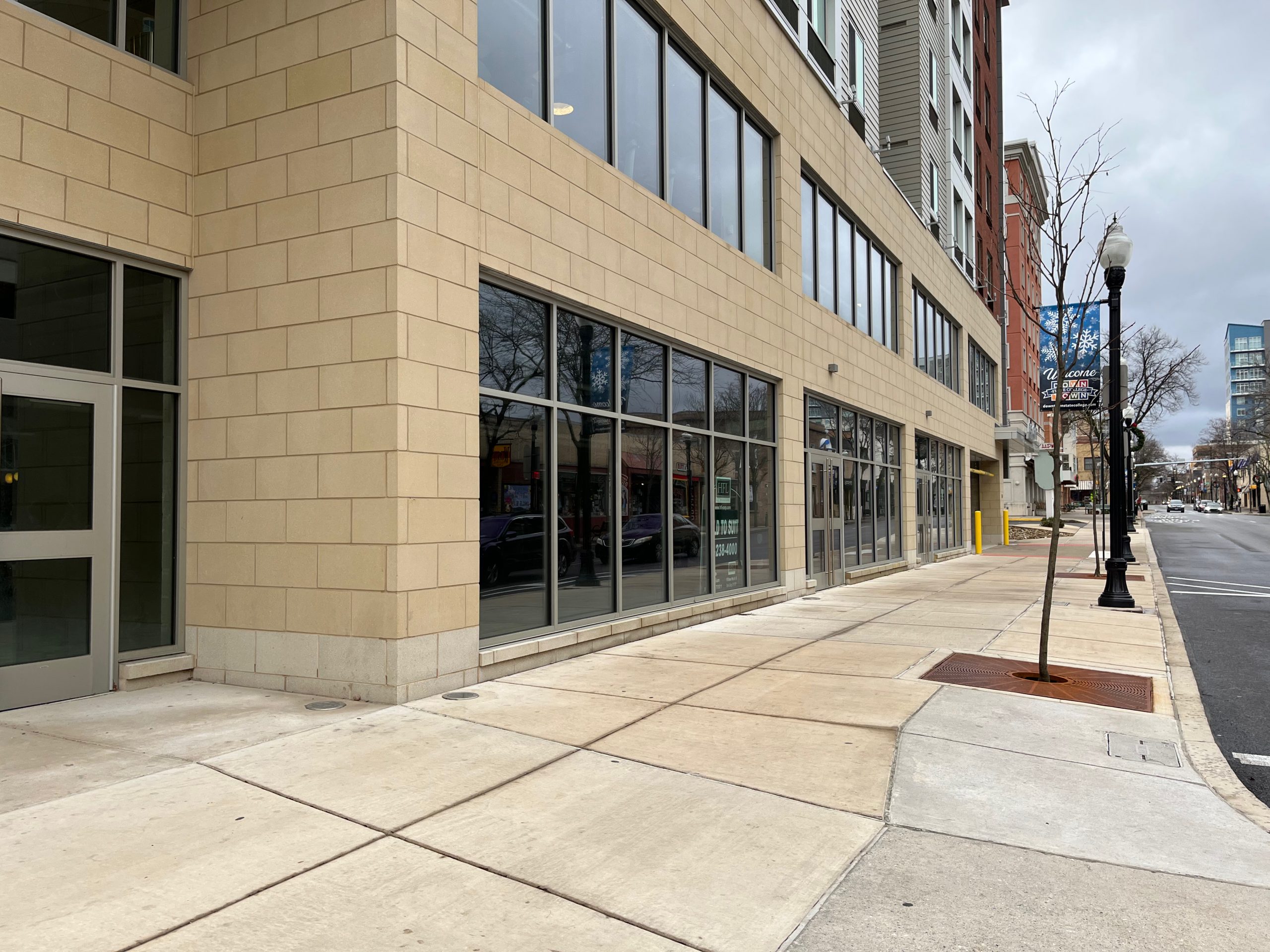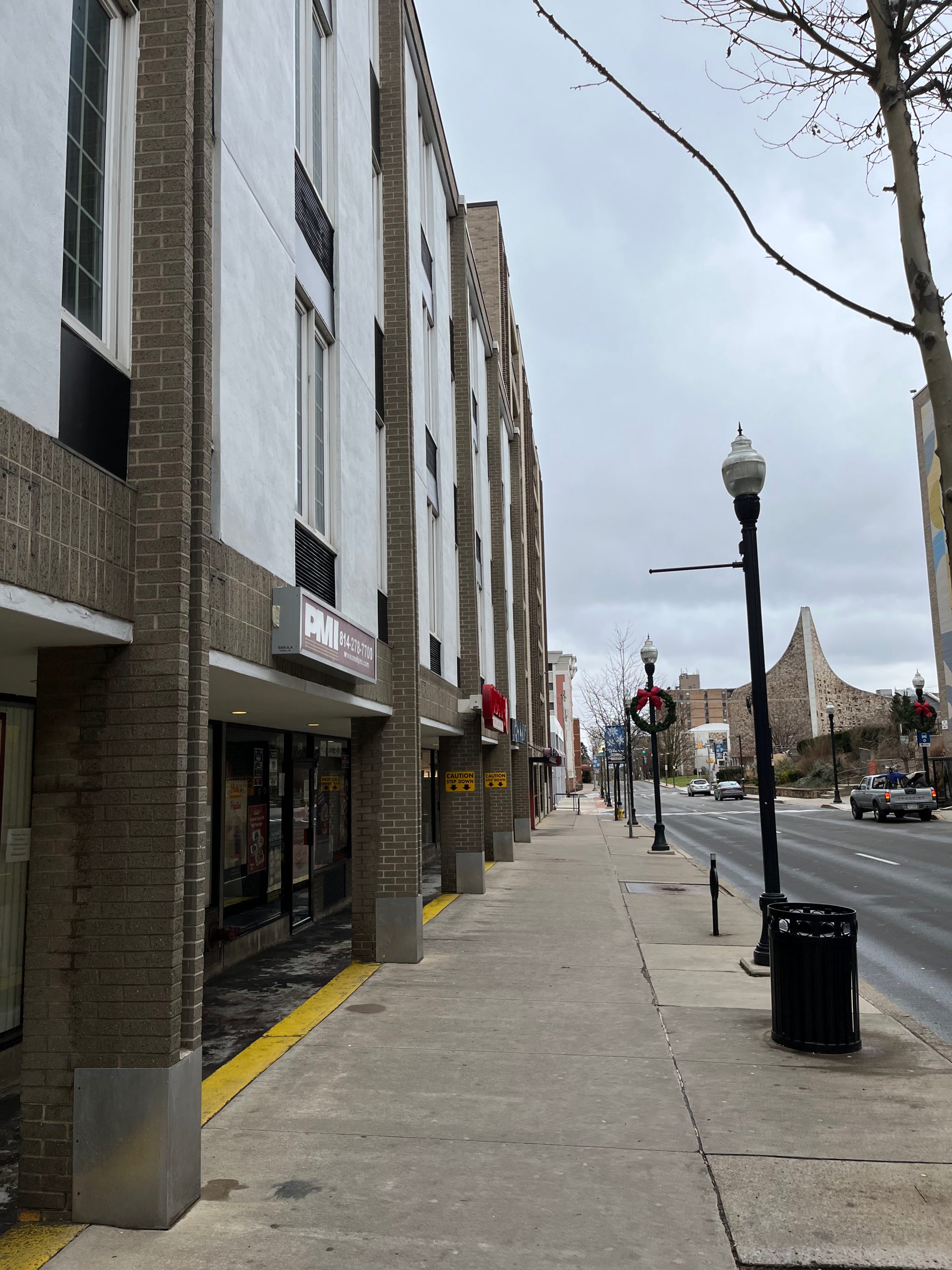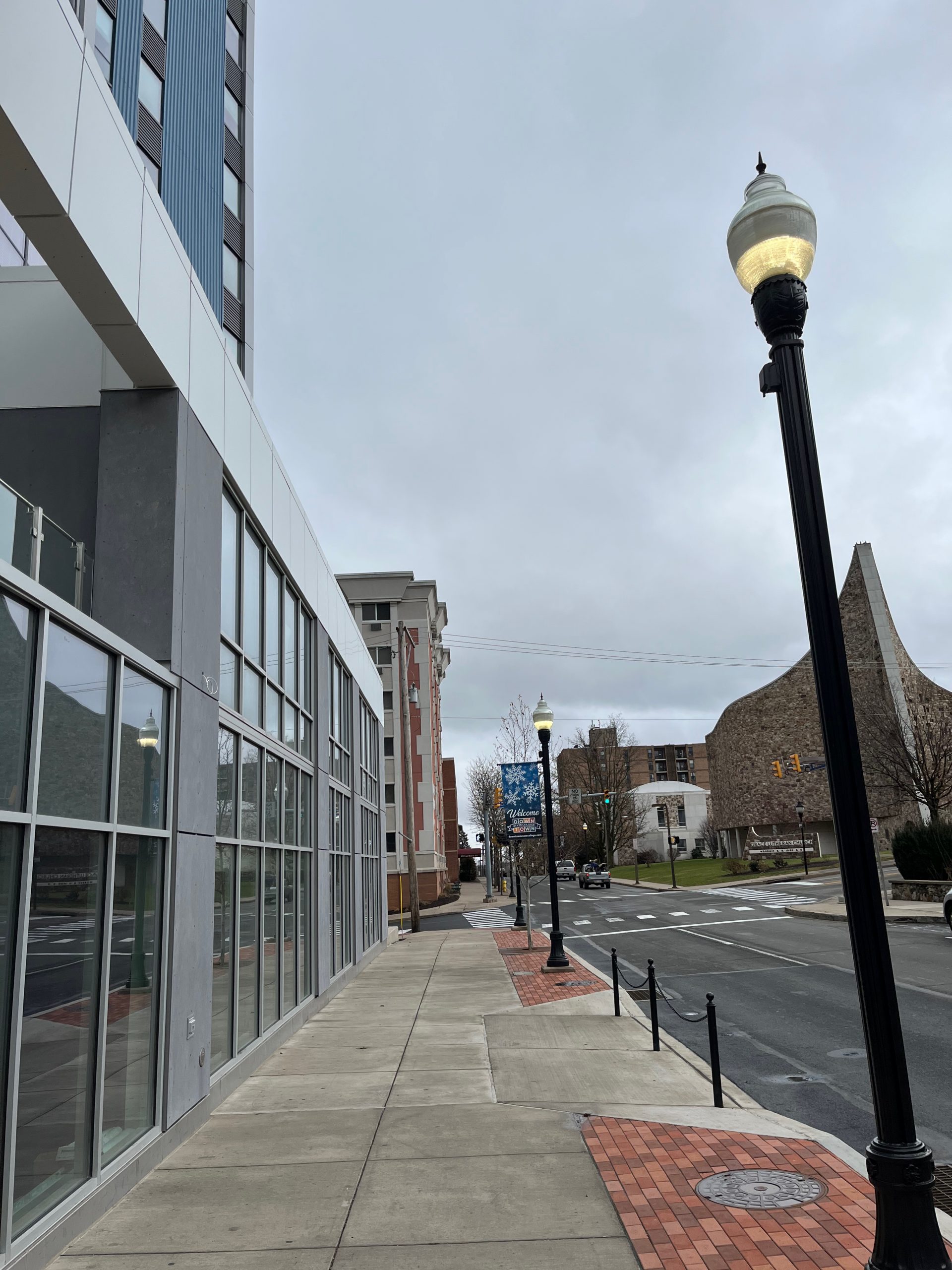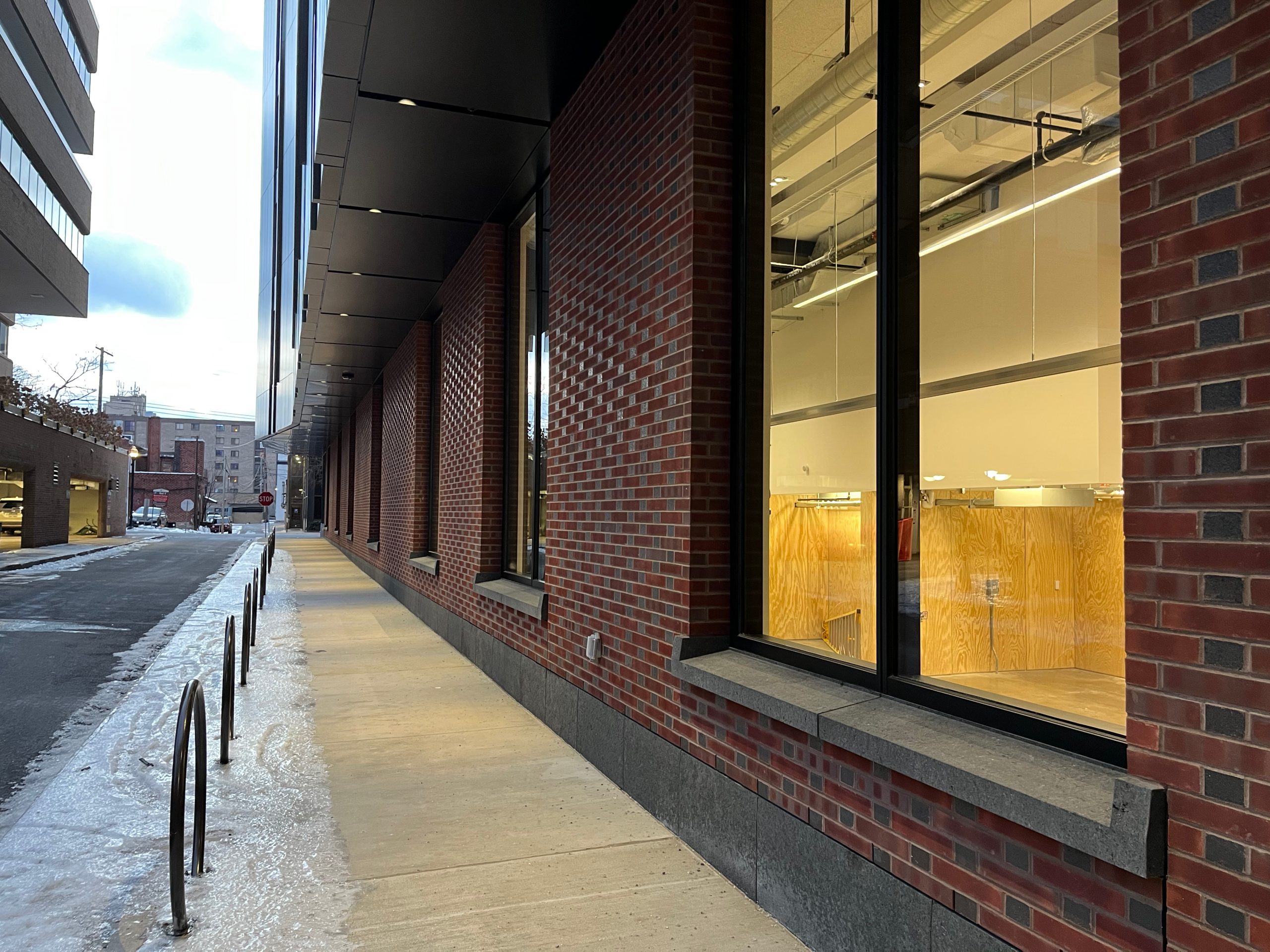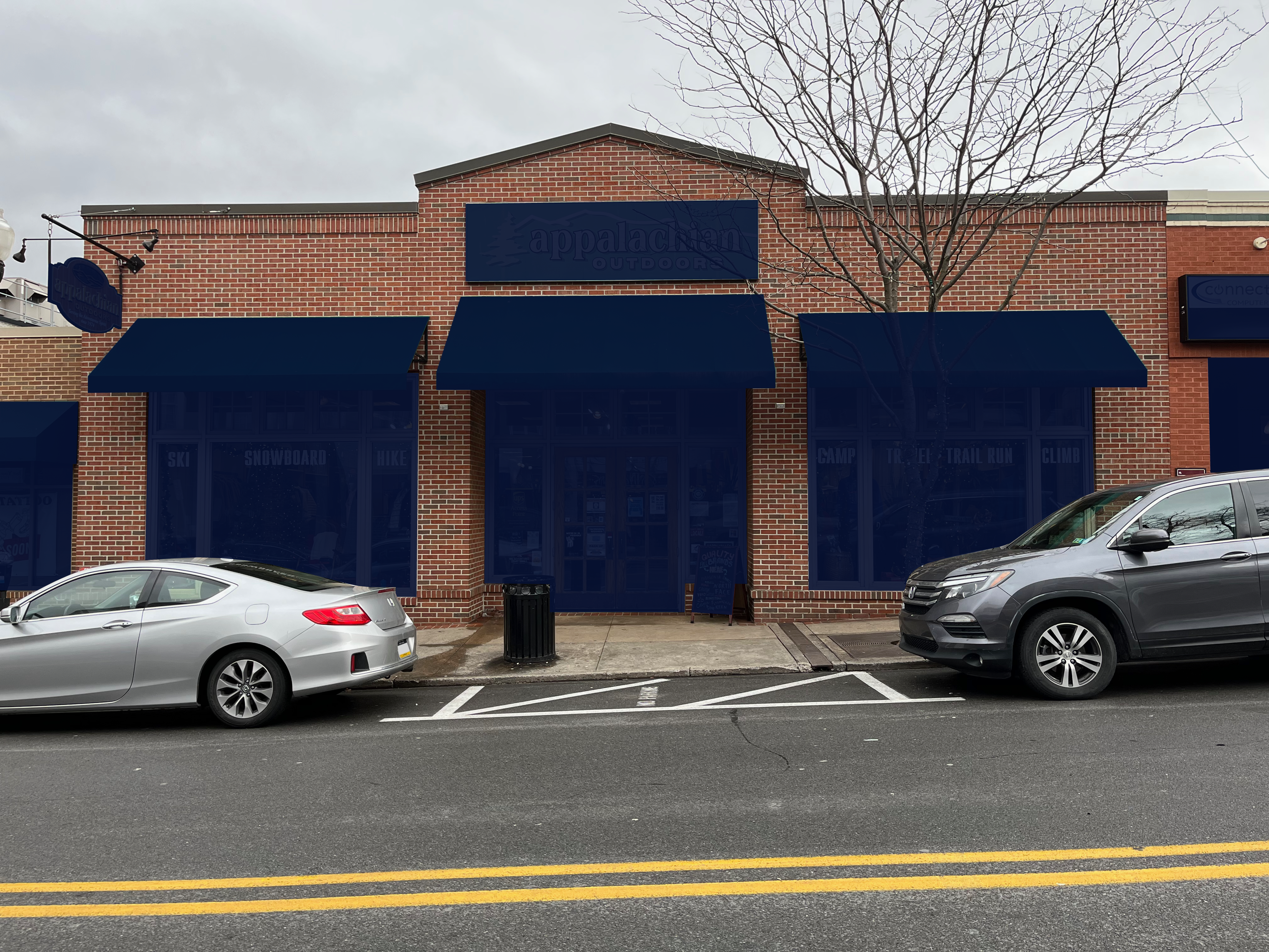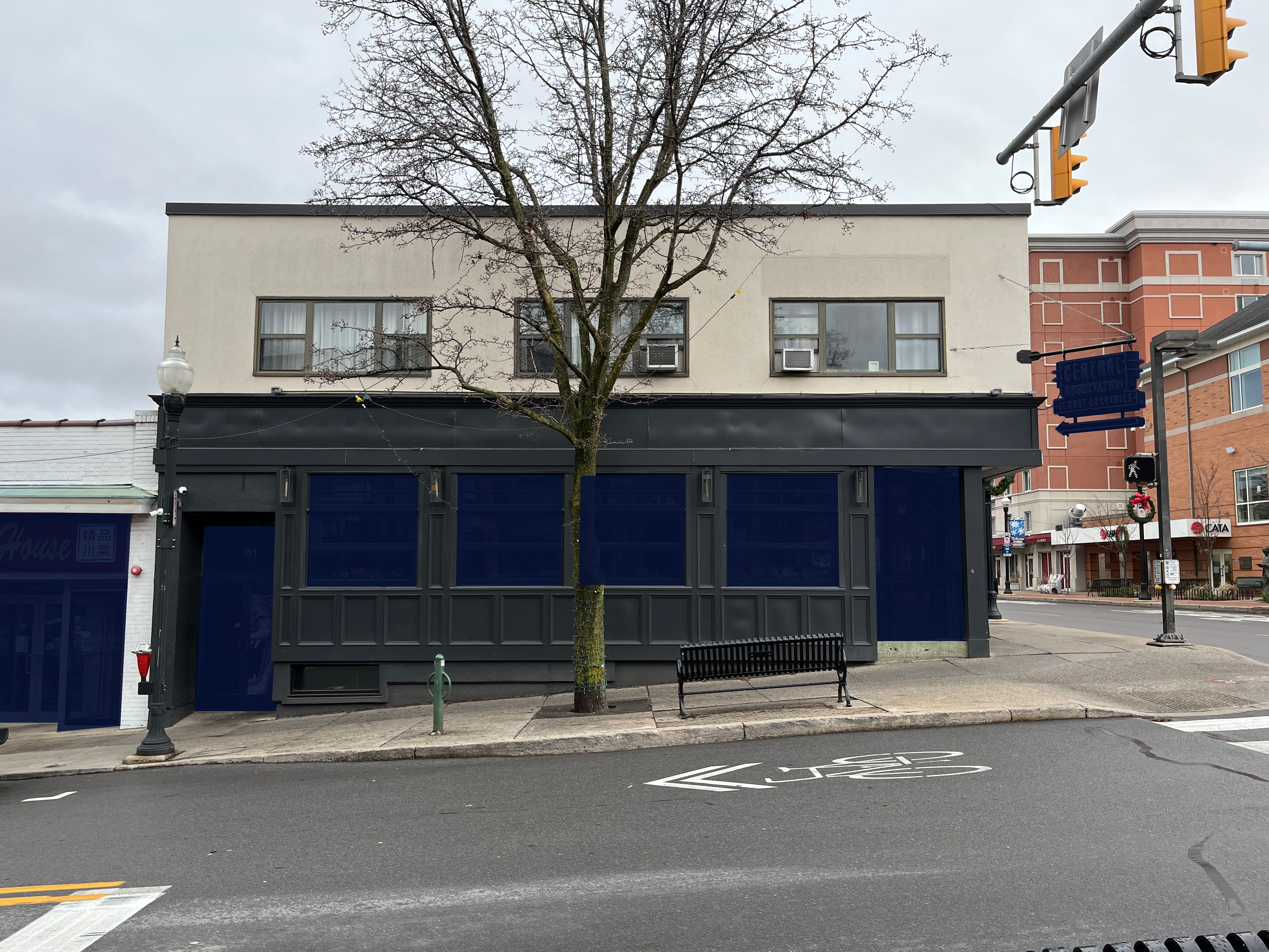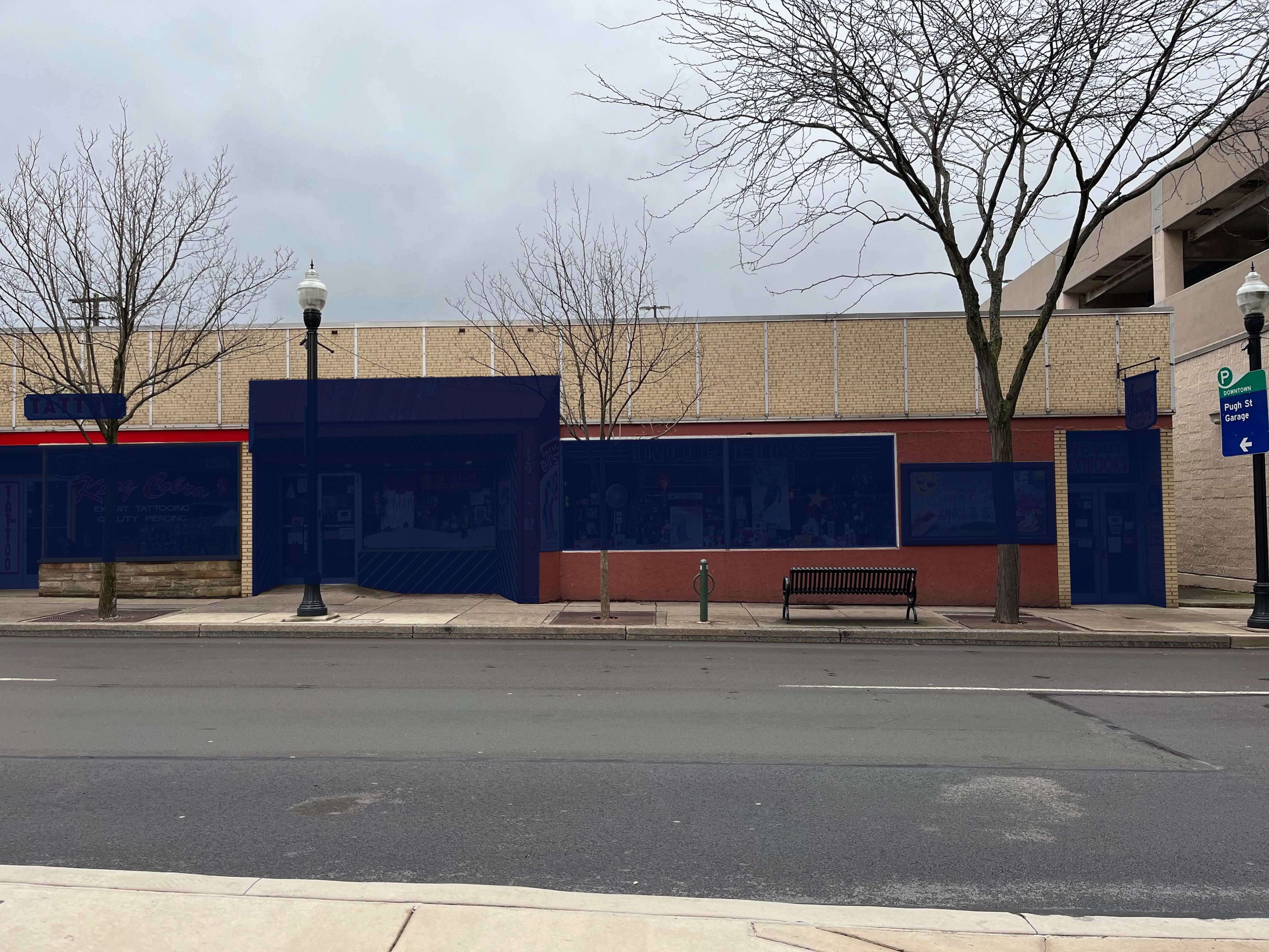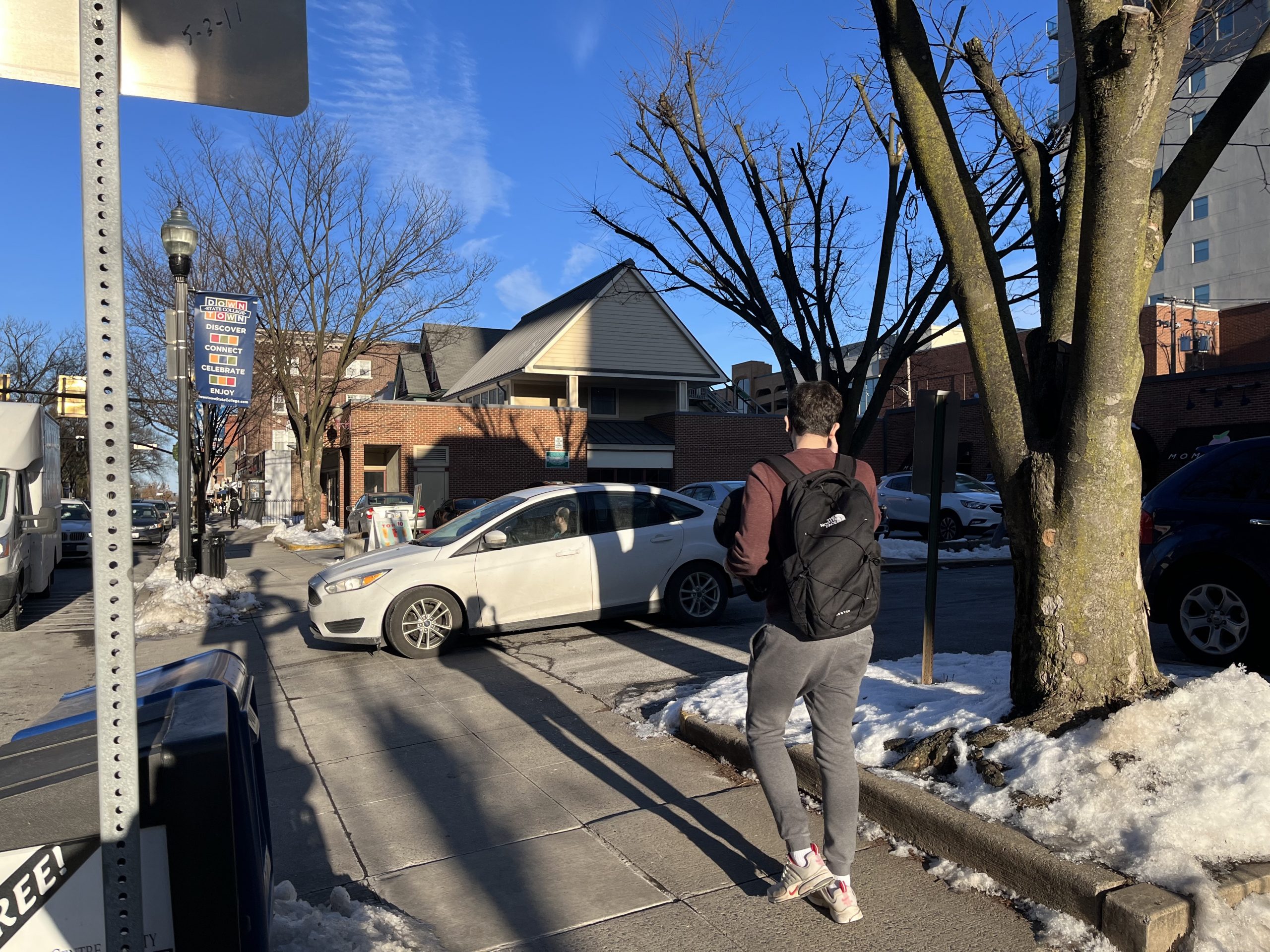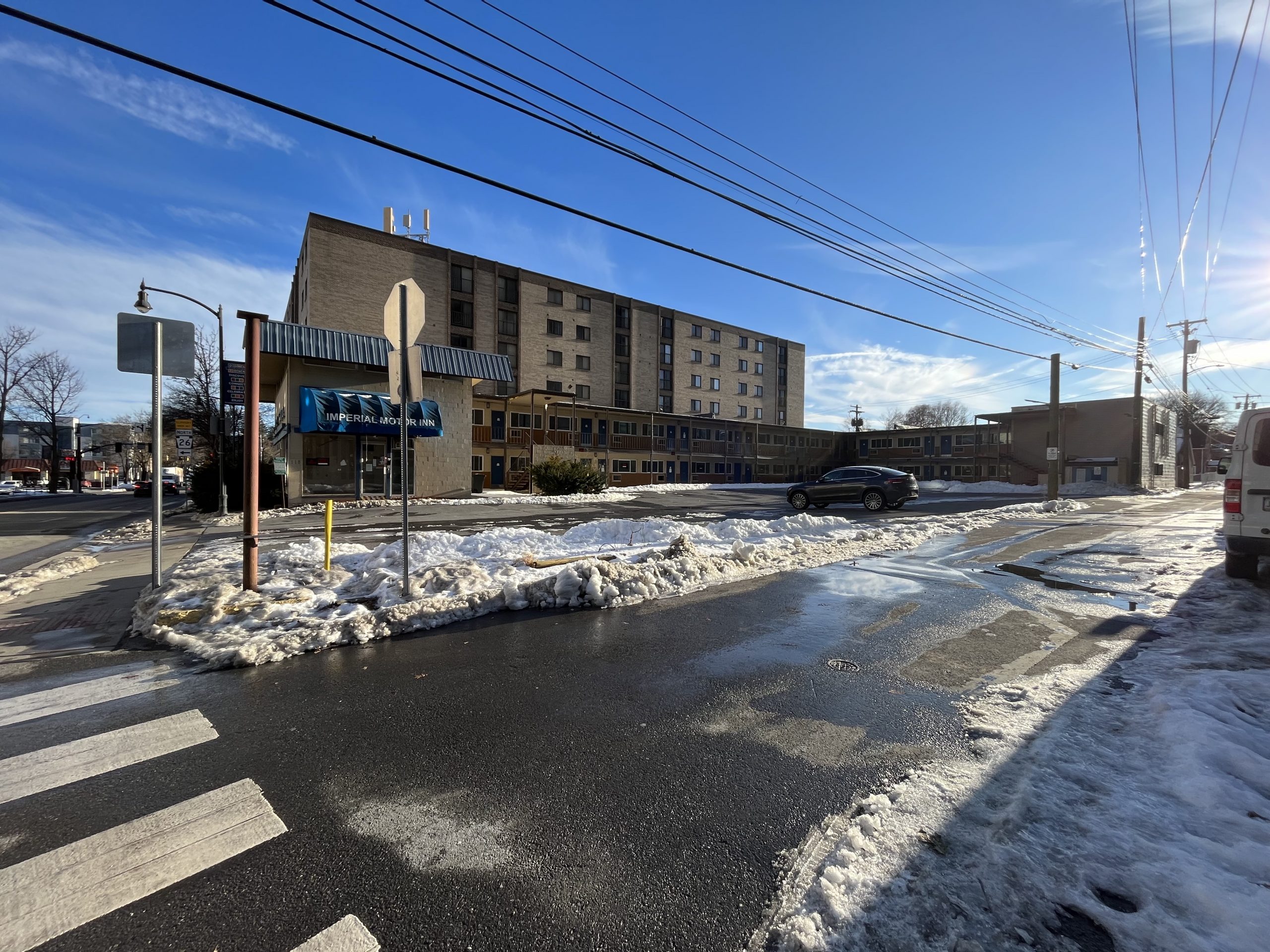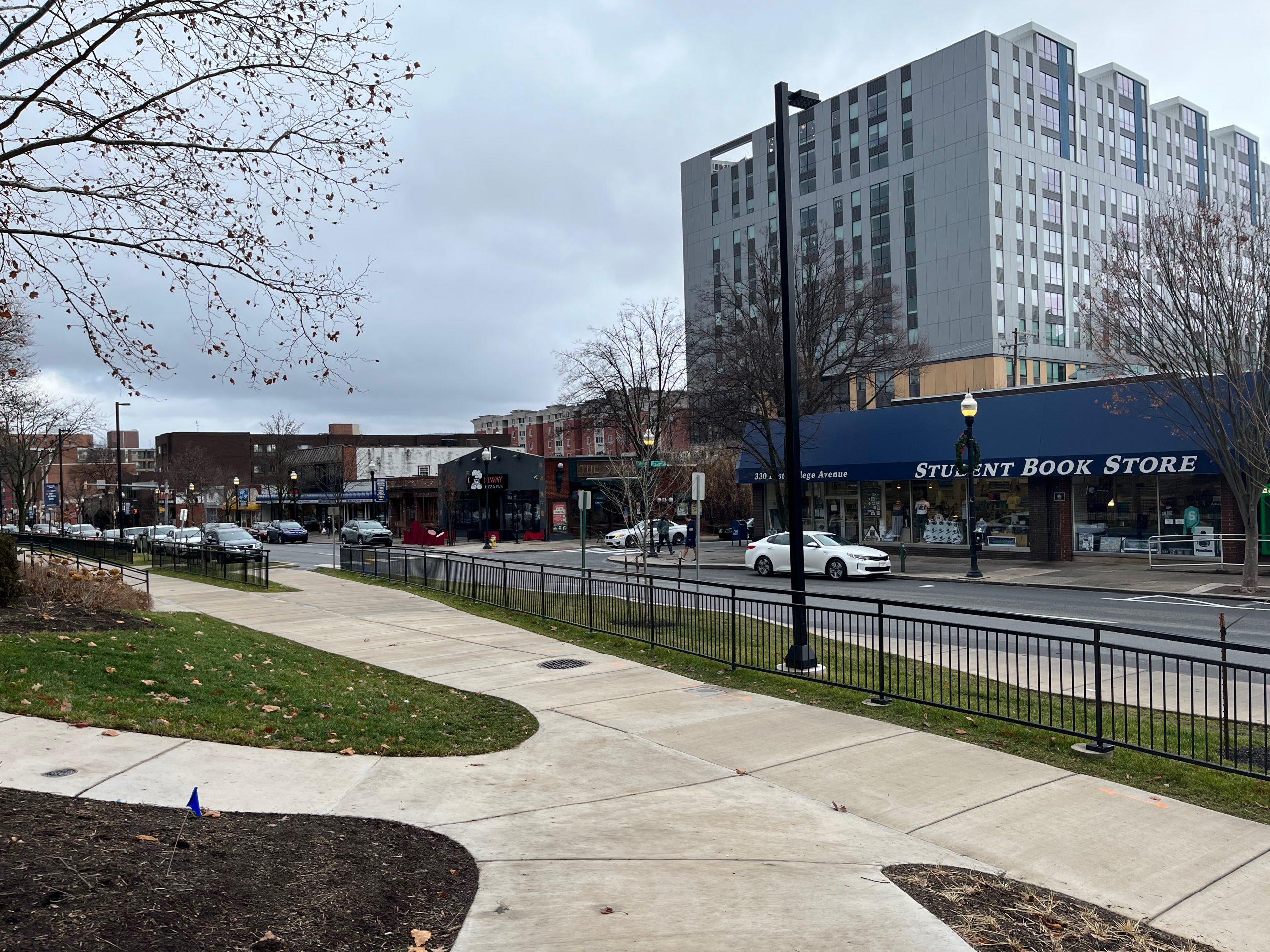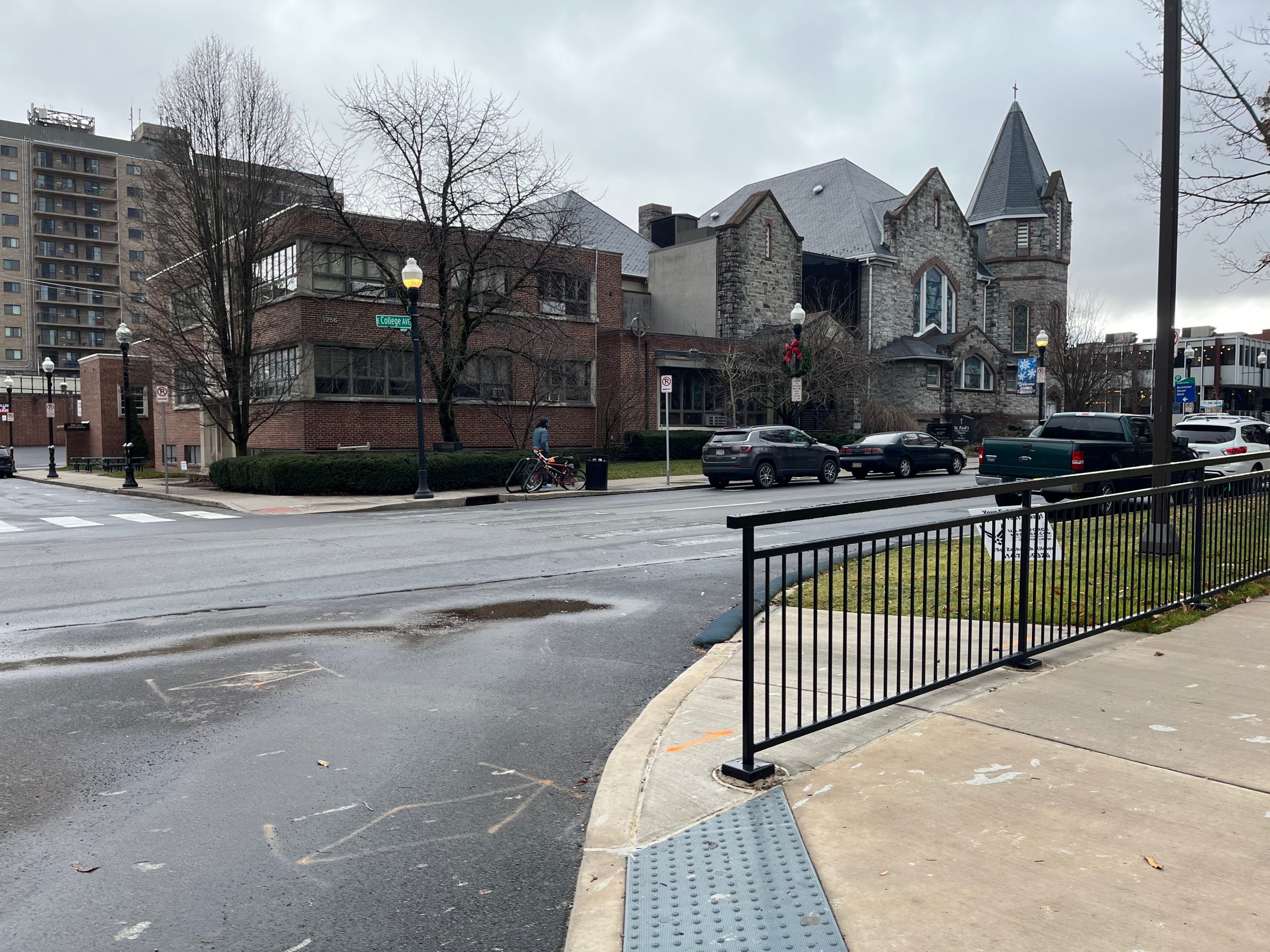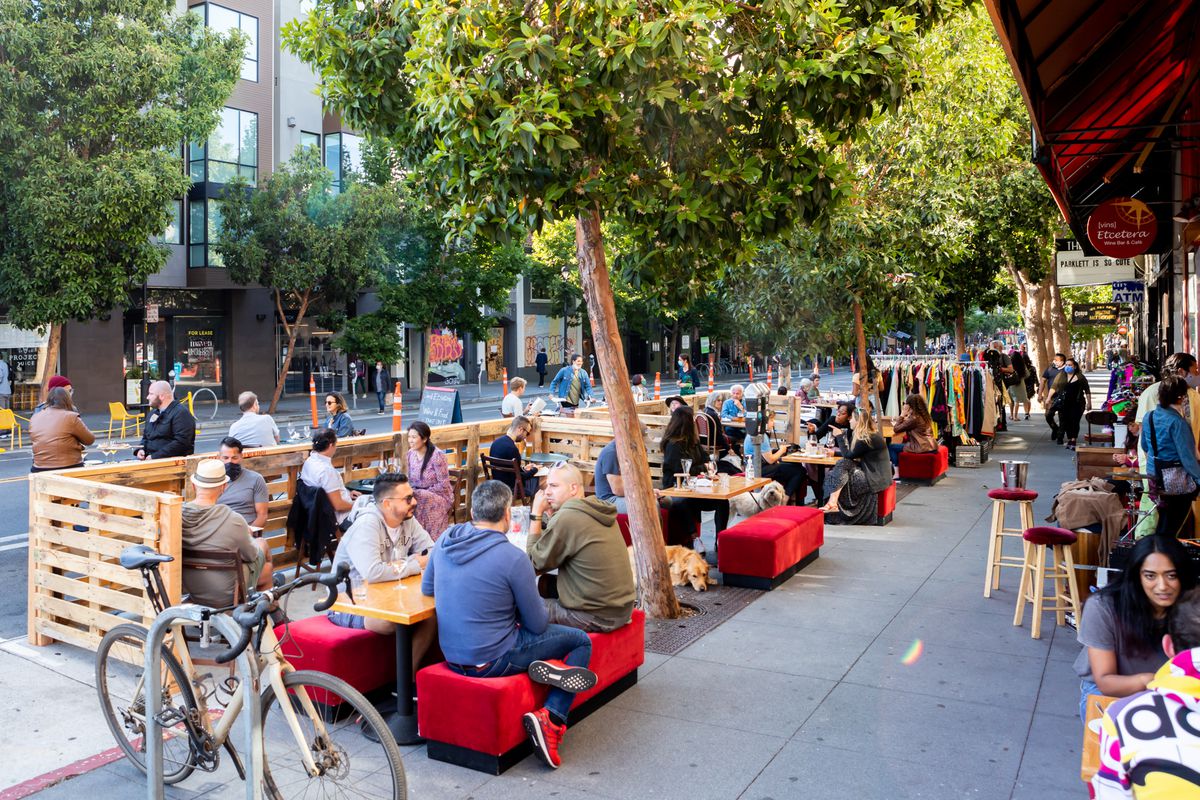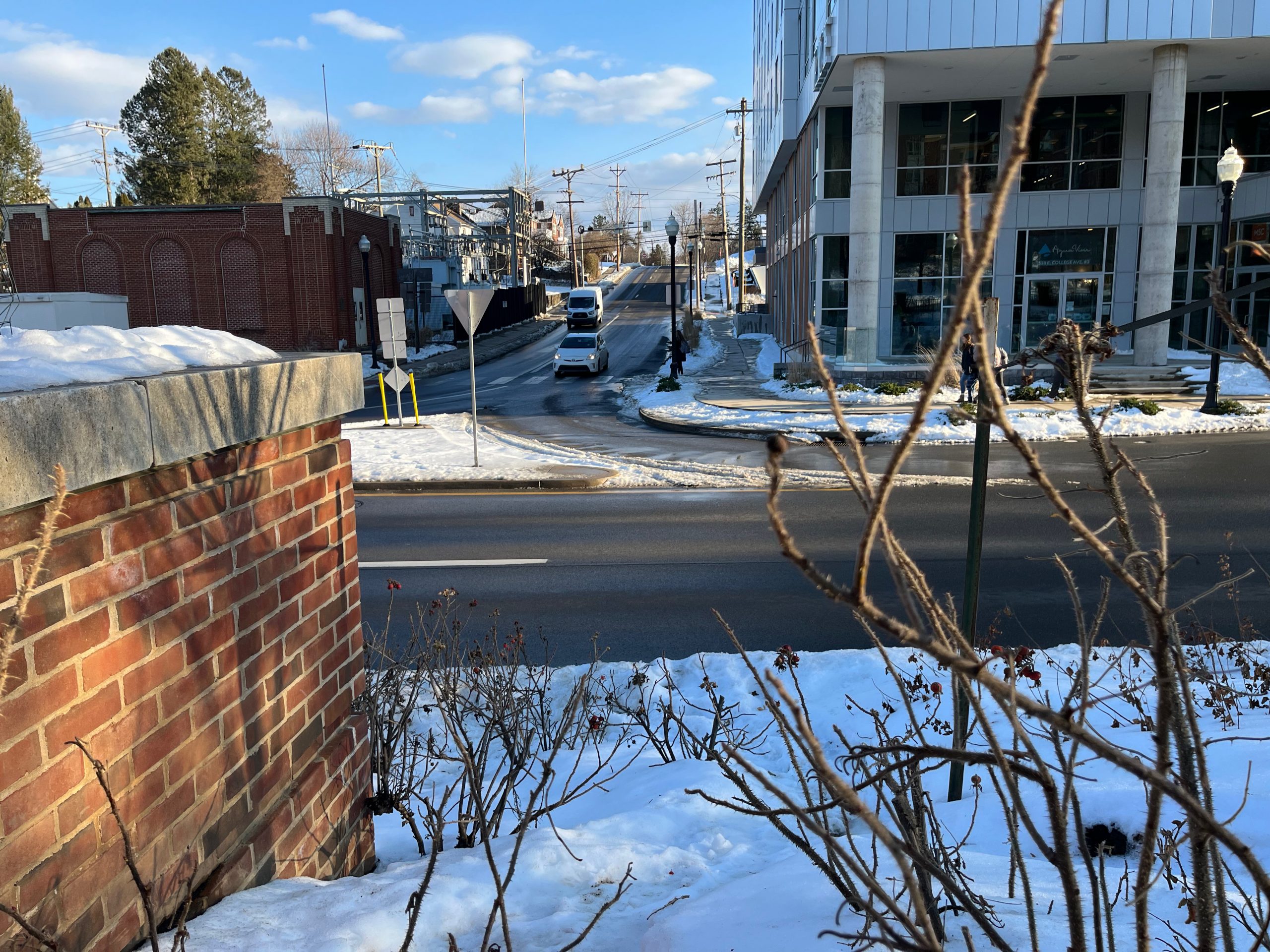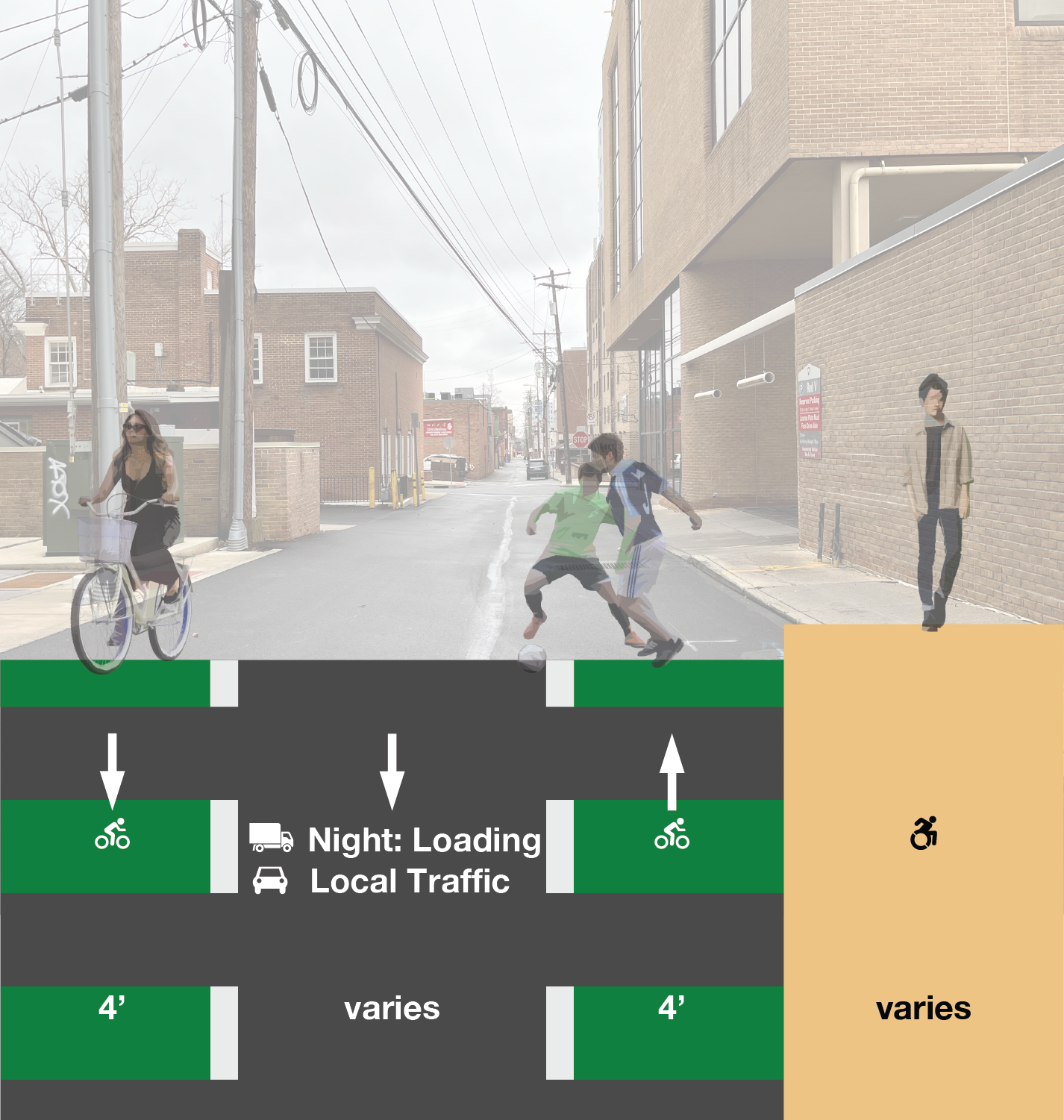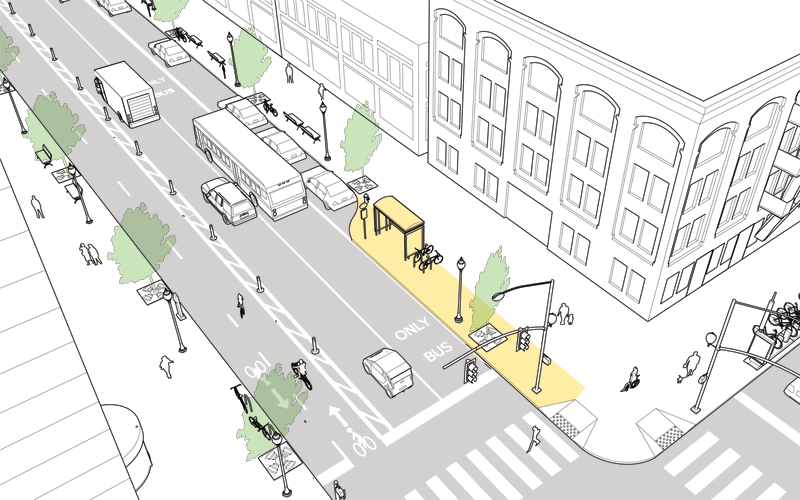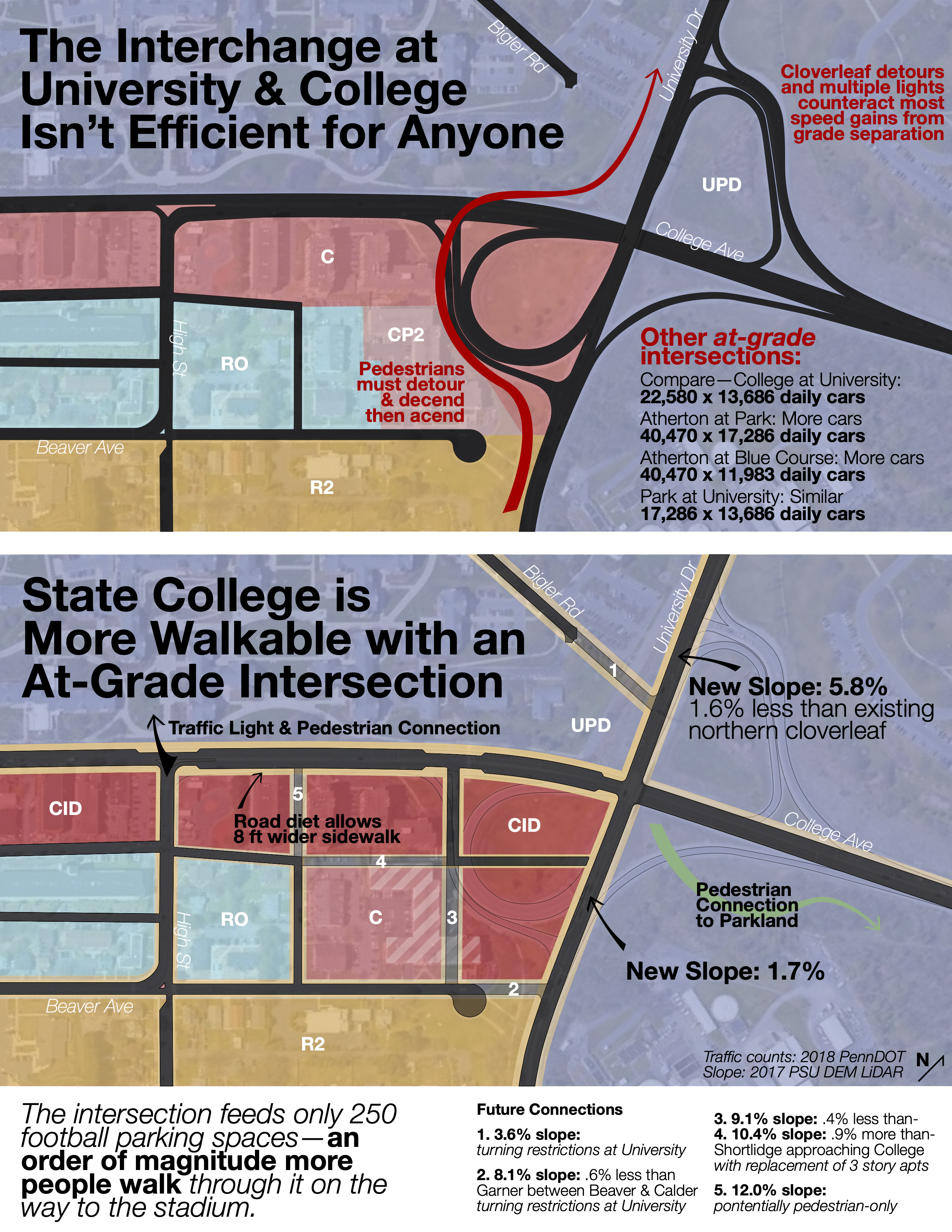individual independent project | 2021
created for use by advocates for a better Downtown State College

State College has one of the single best downtown-campus interfaces of college towns in the US, and probably the world. In Madison, it takes 12 minutes to walk from the State Capitol Building to the closest part of the University of Wisconsin campus. It’s 15 minutes between the University of Illinois and Champaign. It takes 20 minutes of walking uphill to get from Ithaca Downtown Crossing to Cornell. It’s 40 minutes from Ohio State to Downtown Columbus with an interstate in the way. In contrast, you can walk for 20 minutes on College Avenue, with Penn State on one side and Downtown State College on the other the whole time.
Downtown State College is already highly walkable, and its proximity to Penn State campus is a world-class asset. A few simple changes could better align our city with our values:
Ensure inviting ground floors; allow developers freedom on floors 2+
Demand flat, flexible sidewalks with multiple tall storefront entrances following the sidewalk’s slope and support for local businesses in exchange for taller, denser buildings with more housing and less parking.
Eliminate parking minimums to align zoning to values: sustainability, safety, and equity
Like cities across the country, stop mandating new parking to decrease housing costs, make streets safer, increase spending downtown, and make State College more sustainable.
Allocate street space to encourage sustainable, safe, equitable transportation
Build infrastructure to the places people on sidewalks, bikes, and transit want to be: new crosswalks, wider sidewalks, protected bike lanes, bike boulevards, transit signal priority, and bus stops on Atherton.
Ensure inviting ground floors; allow developers freedom on floors 2+
The borough wants a walkable downtown: storefronts, lobbies, and community spaces at ground level; wide sidewalks; activated plaza spaces; local businesses which are interesting and useful to a diversity of residents and visitors. Developers want to maximize returns by building a lot of housing. The borough should allow developers to realize profit building a lot of housing on floors 2 and above in exchange for new, high-quality walkable spaces at ground level that create an improved experience for people on sidewalks.
The borough should require or incentivize:
- Wide sidewalks with limited or no level changes to allow space for movement—especially for people with mobility aids—and flexibility: outdoor shopping in the spring; festival booths in the summer; outdoor dining in the fall; wider sidewalks in the winter.
Eliminating sidewalk level changes increases seasonal and long-term flexibility and gives people with mobility aids more space to move
- Storefronts which accommodate the street’s slope, providing interesting window displays and useful retail entrances along the street’s entire length. Smaller storefronts should be prioritized on the ground floor of buildings along the most important streets downtown, like Allen St and College Ave. Larger retail spaces, especially grocery stores, provide benefits to downtown as well, and should be accommodated above, below, or behind ground floor retail or on less important streets. Urban grocery stores often have a small storefront entry on an important street which leads to a large basement or other interior space, replacing parking.
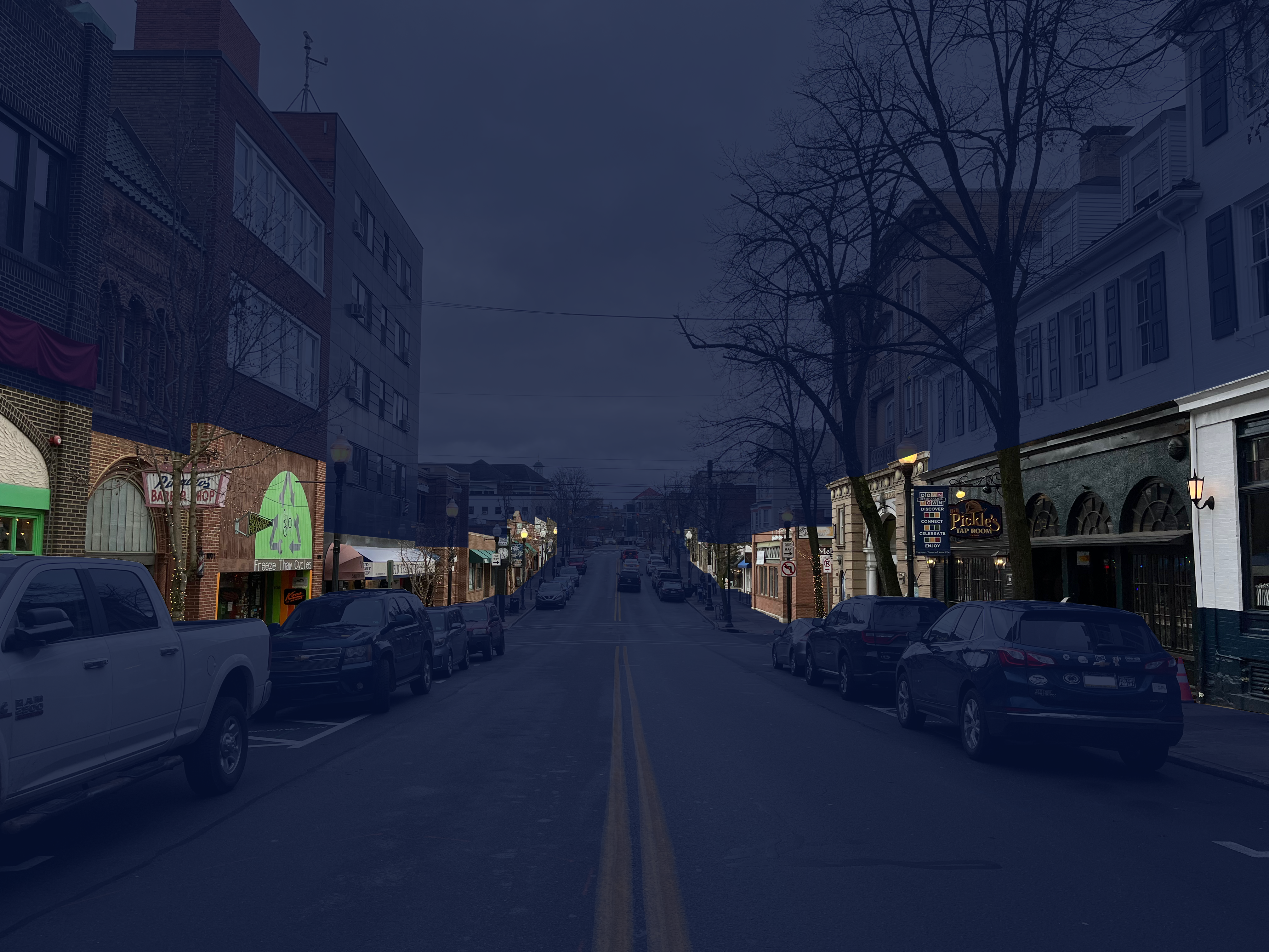
Allen St is inviting specifically because many storefronts and restaurants abut the sidewalk, following its slope 
The Rise combines storefronts which follow the sidewalk’s slope with much higher densities above 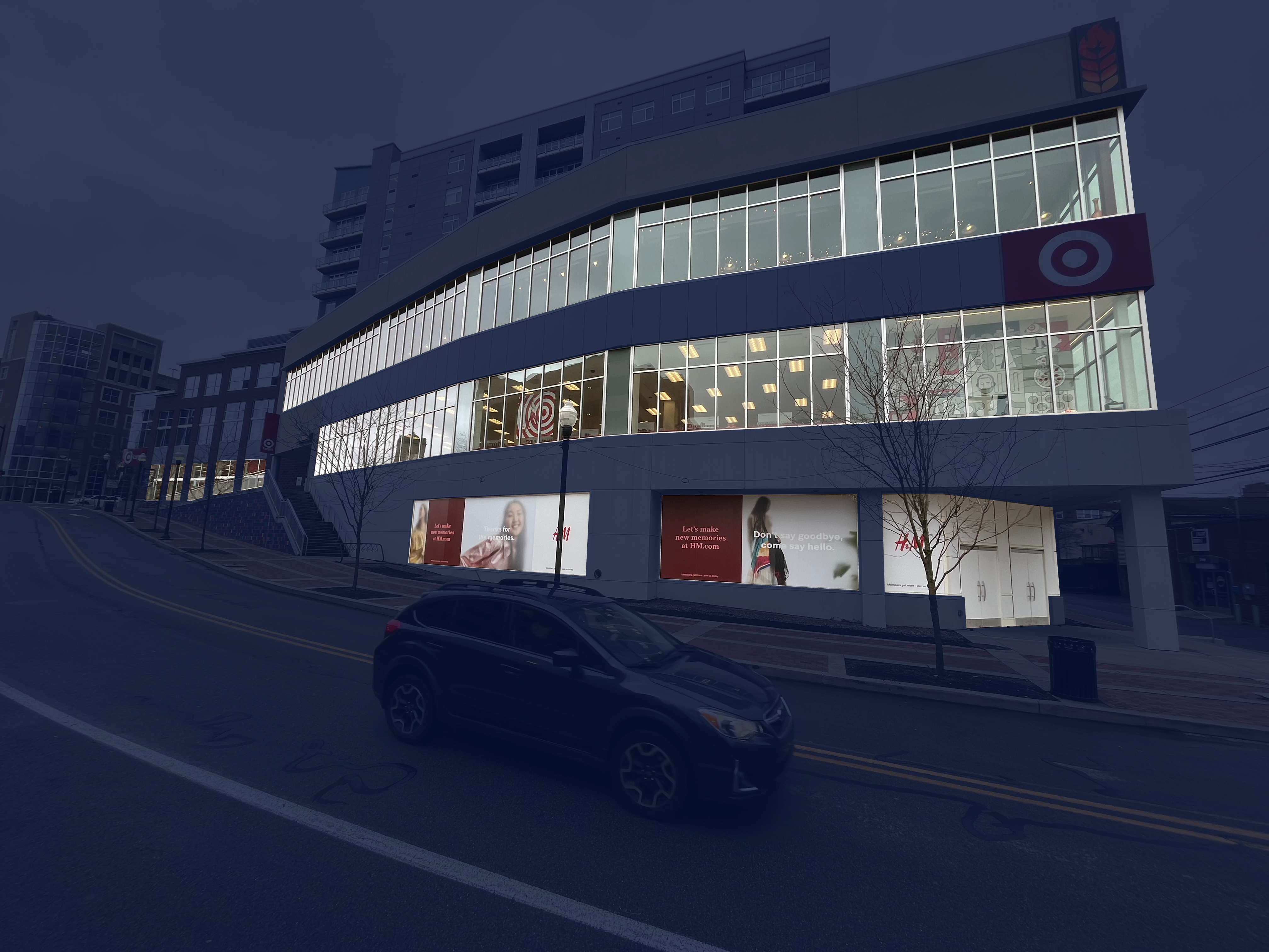
The Fraser Centre features beneficial large retail spaces with entries at the building’s corners; smaller retail with entrances along the slope would provide an even better experience for people on sidewalks
Finding space for large retail like grocery stores downtown—potentially in basements replacing parking—allows smaller storefronts to follow the slope of the sidewalk, engaging people walking by
- Tall ground floors for inviting retail. Limiting height by number of floors rather than number of feet ensures developers don’t shrink the ground floor to gain another residential floor above. State College’s current zoning regulations already limit height by number of stories; future changes should ensure that remains true.
- Support for local small businesses looking for retail space. Finding capital to build out new retail spaces—drywall, interior walls, etc.—is usually a bigger hurdle than rents for small businesses moving into newly built retail spaces. Often chains with millions in capital build out spaces which can later be replaced by small businesses. Alternatively, the borough or developers could share some risk: subsidize the cost of building out retail spaces or guarantee rent for interesting local businesses, especially for businesses whose old locations were demolished for new development. The borough should attempt to save businesses, rather than attempting to preserve the unimportant buildings which house them. This might be the single most effective way of spending money to increase acceptance of new buildings downtown, and could sustain local small business development in the borough.
Many older buildings downtown are just brick boxes; people come to State College for the businesses inside
In exchange for better ground floors, the borough should allow developers more leniency on:
- Height restrictions outside the historic cores of Allen St and College Ave. Allowing taller buildings, especially on the east end of downtown between Garner St and University Dr, would lead to more housing in more inviting buildings—especially at ground level—than currently exist, with little impact on State College’s historic core. Taller buildings shade streets more: a tradeoff in winter, but a reprieve from heat in the summer—and into November or December because of climate change.

Awnings and differentiated facades, already required by zoning, ensure ground floors are human-scale regardless of building height 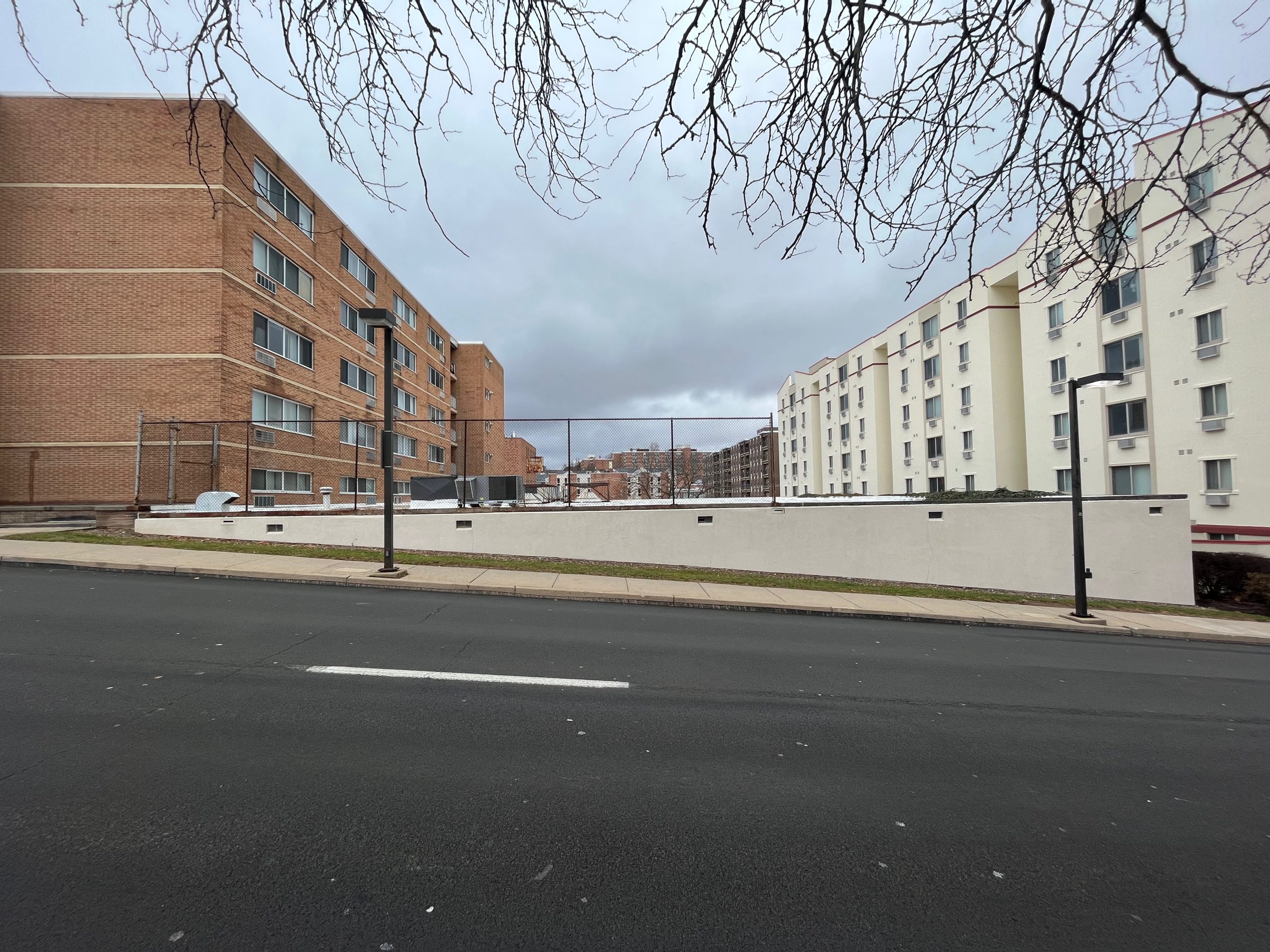
This parcel east of Garner St is ripe for redevelopment but is not included in the Commercial Incentive Zoning District with its larger height allowances, which would make the site more attractive to developers
- Density restrictions. A new development on Pugh Street will demolish a 5-story building to build a 6-story one. The rents needed from 6 stories of housing to pay for the acquisition and demolition of a functional 5 story building, the architectural and engineering work to design a new building, and the common space in that new building can only attract tenants if the demand for housing is much higher than supply, even with multiple new mid-rise developments downtown. If density were doubled, developers would receive a higher return on investment and each renter would need to contribute only half of those fixed acquisition, demolition, design, and common space costs. On the Pugh St parcel, zoning allows 211,205 square feet of residential space, and the proposal includes exactly 211,205 square feet.
- Parking minimums. Jump to learn more.
More housing is good for State College, too. New market rate units are often expensive, but:
- The people paying high rents in new buildings would have outbid others for less expensive units if the new buildings didn’t exist. New units increase the availability of existing less expensive housing. The academic consensus is that new market rate housing decreases housing prices regionally and even adjacent to new development—with zero direct public investment. In State College, this could look like college students moving out of small starter homes in the Highlands, opening them to young professionals.
- Building housing in downtown State College is highly lucrative, so developers will build regardless of zoning restrictions. Spreading fixed costs like land acquisition, existing building demolition, design and engineering, and lobby space and elevators between 12 floors of housing rather than 6 can only serve to decrease rents.
- State College’s inclusionary zoning ordinance ensures developers provide additional new affordable units.
- More housing means more customers for downtown businesses, especially when those residents don’t have cars and spend more money downtown, rather than in neighboring municipalities.
- Taller buildings do a better job enclosing space and creating outdoor rooms. Within the borough’s historic core on Allen St and College Ave, buildings should be at least 3 to 5 stories to expand these outdoor rooms.
Outside of downtown, increased housing supply can take multiple forms, all compatible with existing neighborhood character: accessory dwelling units, duplexes, four-plex retrofits, even small walk-up apartment buildings. Owner occupancy requirements on lots without existing rental permits could allow for more housing while providing supervision of potential undergraduate tenants and ensuring year-round long-term neighbors who come from more diverse backgrounds because of supplemental rental income.

Detatched accessory dwelling unit behind existing houses on Burrowes St 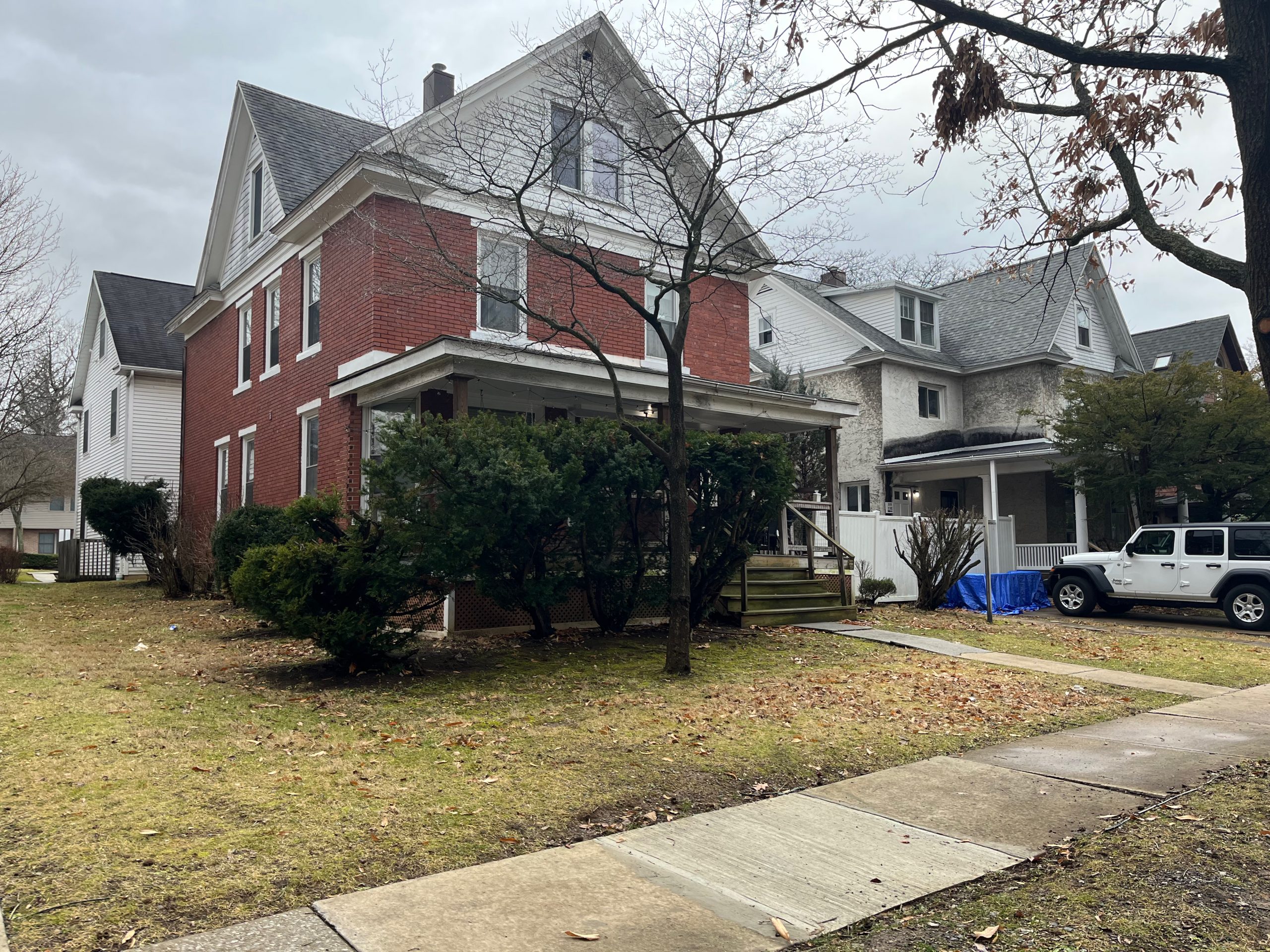
Addition to existing house virtually unnoticeable from Burrowes St 
Low-rise apartment buildings are easily incorporated in downtown-adjacent neighborhoods 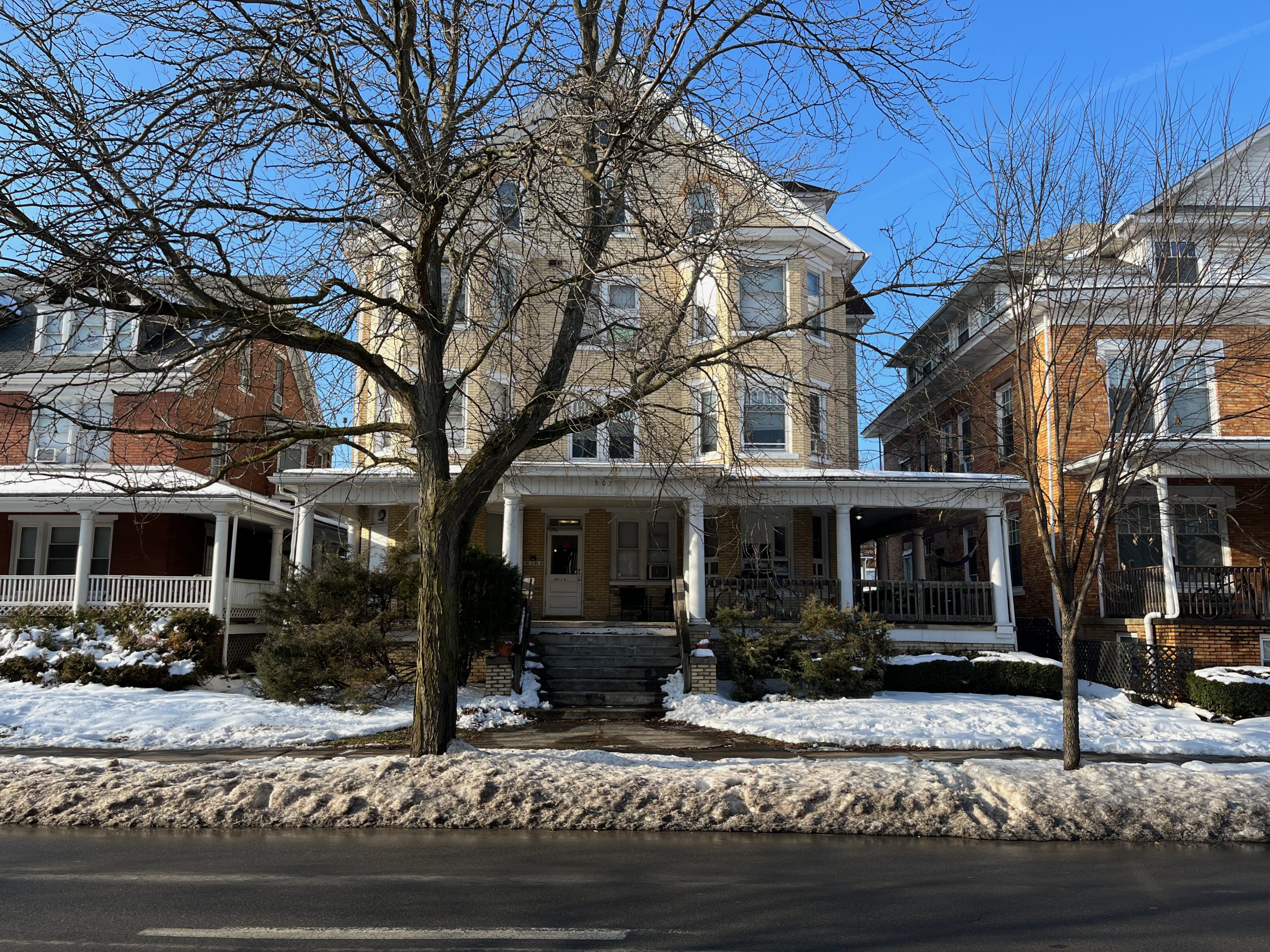
Neighborhood character can be preserved by ensuring higher-density homes look like existing single-family housing
Eliminate parking minimums to align zoning to values: sustainability, safety, and equity
The borough mandates that developers build or pay for parking with any new construction downtown, no matter how small. Almost every developer comments that State College requires more parking than almost anywhere else they’ve worked. At the same time, downtown State College has some of the best alternatives to driving anywhere in the US, and downtown parking structures are only three-quarters full at peak times.
We should eliminate parking minimums, and instead allow developers to determine the optimal amount of parking to build based on demand for spaces and feasibility of construction. Peer cities like Ithaca, South Bend, and Lancaster have already done so.
Cities around the country—often with far worse transit and less walkability than State College—have eliminated parking requirements for new development
Short-term parking, especially street parking, allows visitors from around the region to access downtown businesses. Long-term parking for residents of downtown has no such benefit. In fact, convenient long-term parking only encourages downtown residents to drive outside the borough to spend money.
With less new parking downtown, residents and visitors will find other ways to get around. Therefore, the benefits of eliminating parking minimums include:
- A more sustainable downtown: fewer carbon emissions and less wear on road infrastructure
- A safer downtown: safer, quieter, less congested, less polluted streets which are less stressful to walk or ride through
- A more equitable downtown: mandatory parking increases construction costs and rents by 17%
In the future, the borough should consider parking maximums to create an even more sustainable, safe, and equitable downtown.
Some downtown residents need parking, and we already have plenty for them: only three-quarters of parking spaces downtown are full at peak times. Many more residents don’t:
- Student carpools to and from State College are common and should be encouraged.
- Bus service is abundant to cities in every direction from State College.
- Penn State offers students inexpensive parking near Hastings Road and in the West Parking Deck, accessible via free Loop and Link buses. A short walk between a resident and their car is a helpful deterrent to driving for short trips.
- Commuters to downtown can park in commuter parking outside downtown, ride a CATA bus, or use CATA Commute to carpool.
- Families living near downtown can use CATA service and electric bikes or SPIN bike share to eliminate the need for a second car, or even a first car.
With no minimum requirement for parking, smaller developments are more likely to make financial sense. For example, the last gap in the core College Ave streetwall, the parking lot in front of Five Guys, could be redeveloped, replacing dangerous turning vehicles with interesting retail along the College Ave sidewalk. At a slightly larger scale, the site of the Imperial Motor Inn on Atherton St may be slightly too narrow for a typical underground parking garage, and any alternate garage design may be so space inefficient as to be cost prohibitive. Where parking requirements are currently the barrier to redevelopment, State College could turn surface parking and underused buildings into new retail and housing units by eliminating minimum parking requirements.
We could require or incentivize developers to contribute to White and Blue Loop CATA bus service, improving downtown transportation—including for the residents of new developments—using some of the money they would have spent building superfluous parking spaces. Free Loop and Link bus service is currently funded by Penn State and therefore has a bias toward campus service: White and Blue Loops often leave downtown headed to campus so full that some riders are left behind to wait for the next bus. Increased funding could support more Loop service: more buses during weekdays to increase frequency and capacity, or new buses in the early morning and late at night when no buses currently run. Learn more strategies to improve transit downtown.
If the borough finds it necessary to increase public parking downtown, consideration of the following could limit negative externalities:
- Consider partnerships with Penn State, whose garages are usually only full during work hours, or private garages downtown which are consistently under-full.
- Consider building new parking structures on land currently occupied by church parking lots, especially Grace Lutheran Church on Garner St. Church parking lots are usually only full on Sunday mornings, a time with low public parking demand. The borough would gain additional parking, the church could gain revenue, and people walking downtown would gain a more interesting streetwall replacing a surface parking lot.
- Wrap ground floor retail around parking structures to ensure interesting streetwalls. For example, Beaver Garage includes retail along Beaver Ave.
- Build multiple floors of housing or office space above parking structures to increase density and offset land costs.
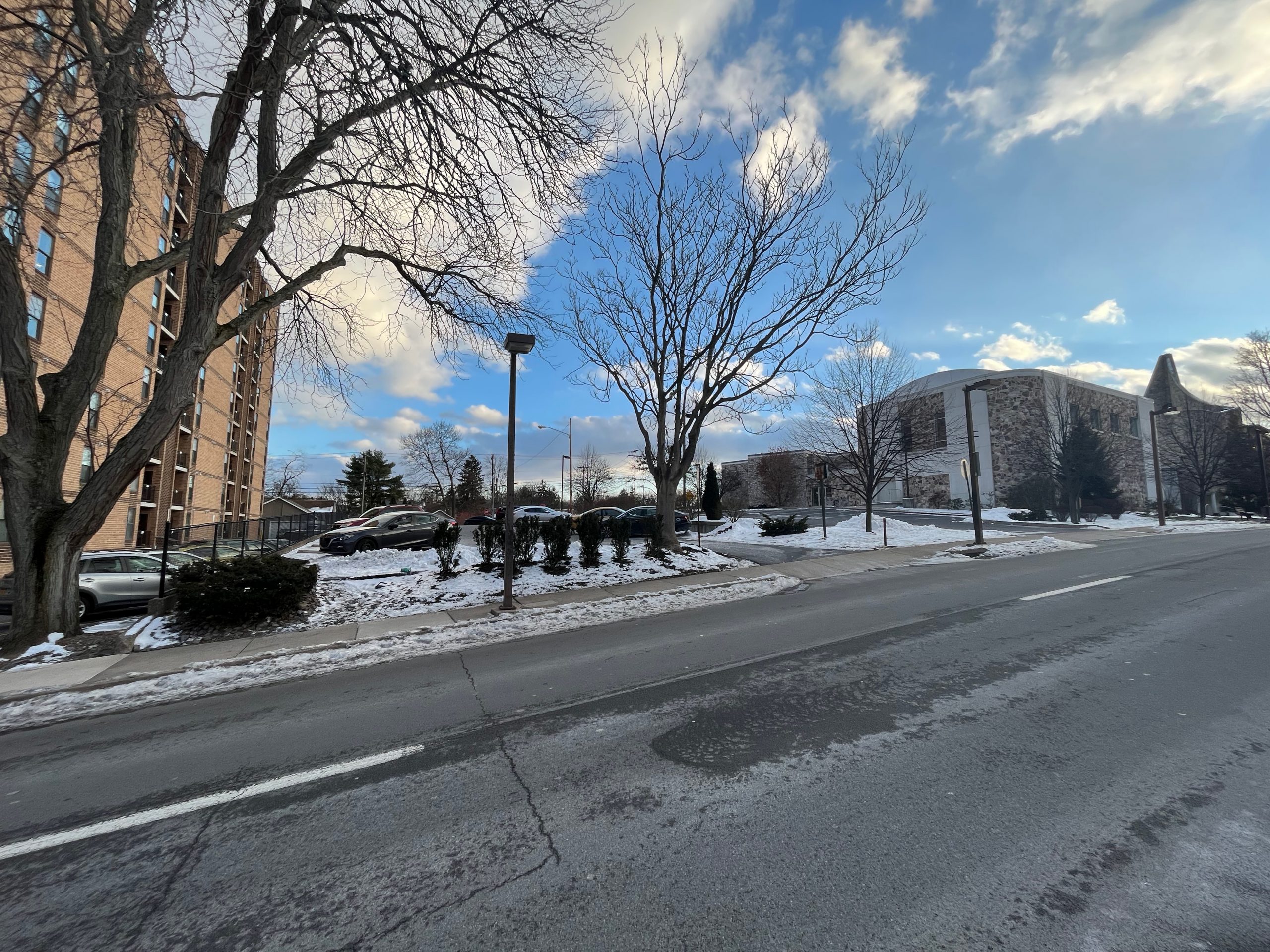
Church parking lots—unlikely to redevelop and busiest when public parking is not—are good locations for new parking structures 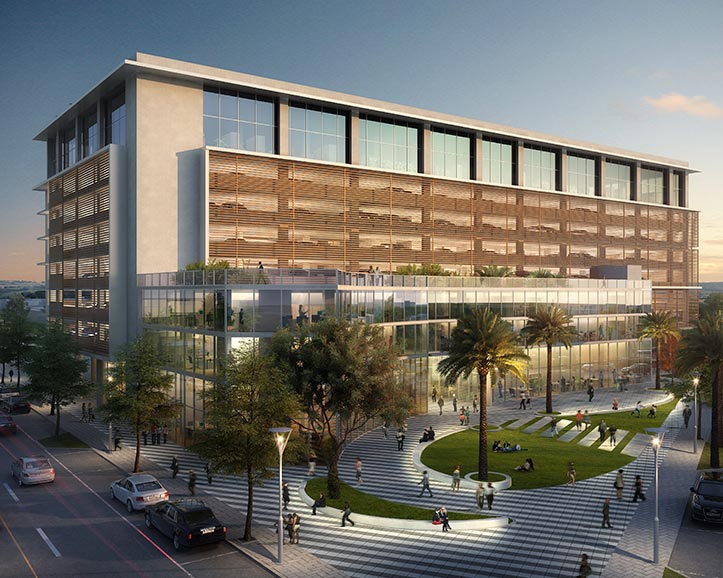
Parking structures should include retail on the ground floor and can host residential or commercial space above (Bermello Ajamil & Partners, Inc.) 
Beaver Garage includes retail on its ground floor to improve the Beaver Ave streetwall
Streets adjacent to downtown already have parking restrictions which, in tandem with cheap long-term parking on campus, prevent downtown residents from parking on neighborhood streets long-term.
Allocate street space to encourage sustainable, safe, equitable transportation
How we choose to allocate scarce resources betrays our values. Street space is one such resource. We can choose to provide wide sidewalks for convenient walks, protected bike infrastructure for safe rides, and dedicated rights-of-way for efficient transit trips. If the infrastructure is built—or even just painted—it will induce demand for even more mobility options.
State College can better design for people on sidewalks:
- Rather than being tempted to install fences that inconvenience pedestrians to stop jaywalking, study where people want to move and create infrastructure to accommodate those wants. Removing fences inconveniencing pedestrians along College Ave could better connect downtown and campus. Evidence suggests the existing inconvenient fences do not improve safety: there have been two mid-block car crashes with pedestrians on College Ave between Burrowes St and Sowers St since 2010 (where fences inconvenience pedestrians everywhere except at intersections and bus stops). There have been two similar crashes on the same stretch of Beaver Ave, without any fences. In addition, fences force people who park on the campus side of College Ave to jaywalk, because they block sidewalk access on that side of the street.
Fences inconveniencing pedestrians increase jaywalking by people accessing the parallel parking on the campus side of College Ave
- Install crosswalks on both sides of intersections with College Ave. Currently, many intersections lack a crosswalk across College Ave on their western edge (closer to Atherton St and farther from University Dr). The crosswalks were removed to ensure turning vehicles need not wait for crossing pedestrians, and for the marginal safety benefit of separating turning vehicles from crossing pedestrians. Their removal inconveniences people on sidewalks in exchange for faster—therefore less safe—vehicle traffic. During multiple counting sessions at various times during the fall semester, 6 times as many pedestrians (441) crossed College Ave at Heister St, and 1.5 times as many pedestrians were visibly inconvenienced by the lack of a crosswalk on the intersection’s western edge (114), as cars turned from Heister St onto College Ave (73). Installing crosswalks on all intersection edges allows people on sidewalks to choose to inconvenience themselves for a marginal safety benefit or to cross with the convince and risk standard at virtually any other intersection in the region.
- Expand sidewalks into parallel parking and too-wide vehicle lanes, especially where sidewalks are unacceptably narrow. Expansion can happen with tan paint first, then with concrete when the street is reconstructed. On Beaver Ave east of Pugh St, sidewalks are as narrow as 5 feet, and vehicle travel lanes are more than 10 feet wide. Narrowing travel lanes to 10 feet slows vehicles without reducing vehicle throughput; slower vehicles and wider sidewalks improve real and perceived safety for people using those sidewalks. Wider sidewalks also better accommodate more people and people with mobility aids. College Ave between High St and University Dr is currently 5 lanes of speeding traffic, but traffic volumes, 15,785 cars per day, only justify 3: a three lane road diet has capacity for 20,000 cars per day. A road diet to 3 lanes and an expanded sidewalk would slow cars and improve comfort for people on sidewalks. Expanded sidewalks abutting new development should lack level changes to maximize flexibility.
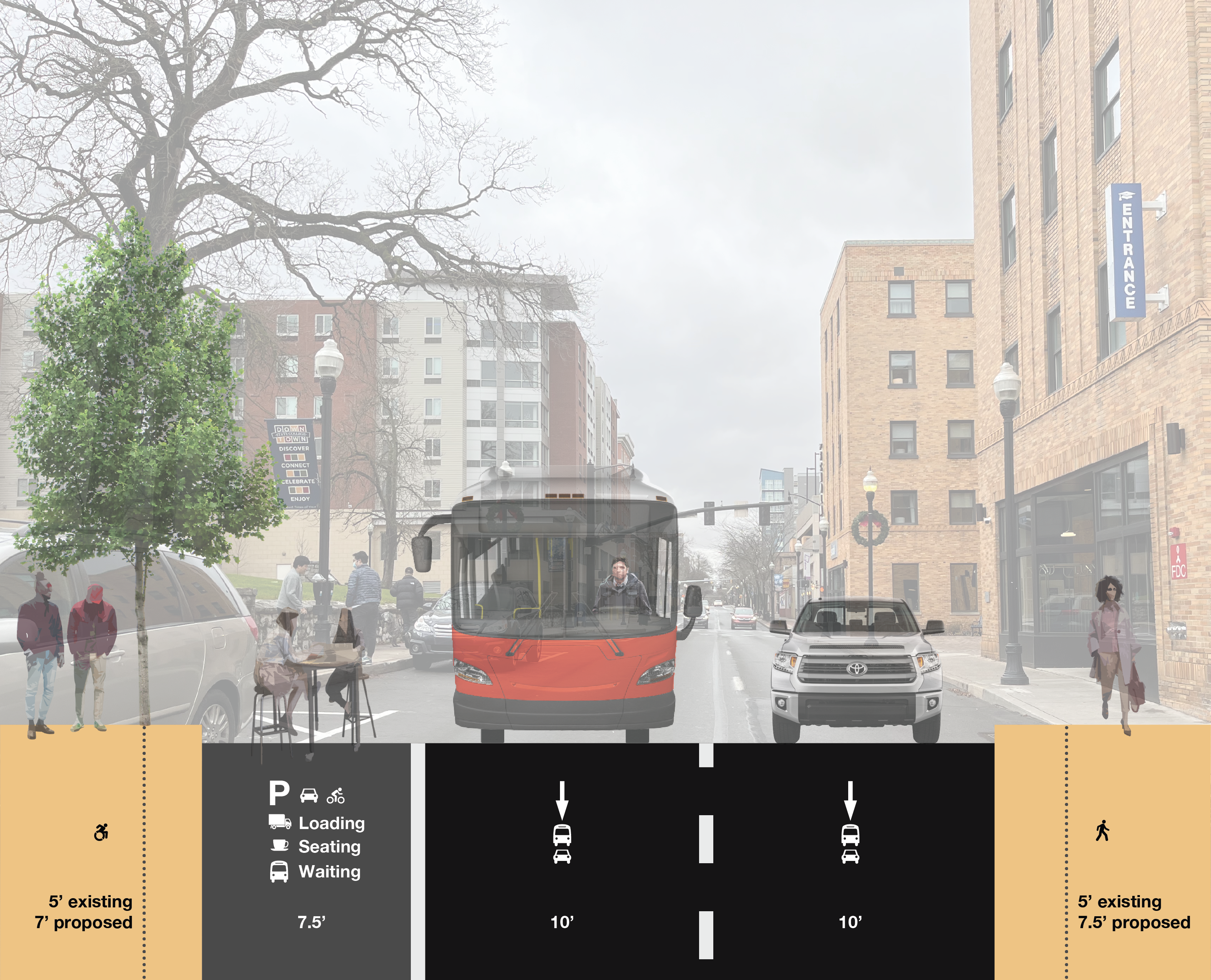
Beaver Ave at Pugh St: narrowing lanes to 10 ft provides 4.5 ft of new sidewalk width

College Ave at High St: road diet to 3 lanes provides parking lanes and 8 ft of new sidewalk width
- Allow outdoor dining anywhere there is space, especially where that space is currently used for parallel parking. Outdoor dining space is best placed in parallel parking stalls to allow unobstructed sidewalks for movement and to buffer people on sidewalks from moving vehicles. It is certainly reasonable for businesses to pay for the space their outdoor seating occupies if it is within the public right-of-way, but the benefits of outdoor dining to street life—as compared to parked cars—must be taken into account when determining fees.
Outdoor dining in parallel parking spaces buffers people on the sidewalk from traffic lanes while allowing unobstructed movement (Eater SF)
- Open Allen St between College and Beaver to people on foot and bikes only, all year long. There are enough people on Allen Street’s sidewalks already to activate the entire street width, retail and restaurants could benefit from expanded outdoor shopping and dining, and State College would gain a full-time central square. Low traffic volumes would mean little disruption to vehicles, and nearby bus stops and parking on College Ave and Beaver Ave provide ample accessible mobility options. This car-free area could later be expanded along Allen St toward Foster Ave, on Calder Way in both directions, and on other cross streets like Pugh St or Fraser St.
- Intentionally plan where building services can be best concentrated to ensure dumpsters and driveways do not interrupt important sidewalks. Placing services on frontages with fewer pedestrians will reduce unsafe conflicts where vehicles cross sidewalks. Already, current zoning aims to contain some building services, like driveways for some businesses, away from important streets like College Ave and Beaver Ave. HERE on Garner St has building services along Heister St because Beaver Ave, Garner St, and Calder Way are the more important frontages. Unfortunately due to minimum parking requirements, the Pugh Centre necessitated a garage entrance on Beaver Ave, limiting valuable storefront area and endangering people on the sidewalk with turning vehicles and poor sight lines. To ensure this never happens again, garage entrances and other building services should be prohibited from important streets like Beaver Ave, College Ave, Burrowes St, Allen St, Pugh St, and Garner St and minimum parking requirements should be eliminated so architects don’t need to consider such garage entrances.
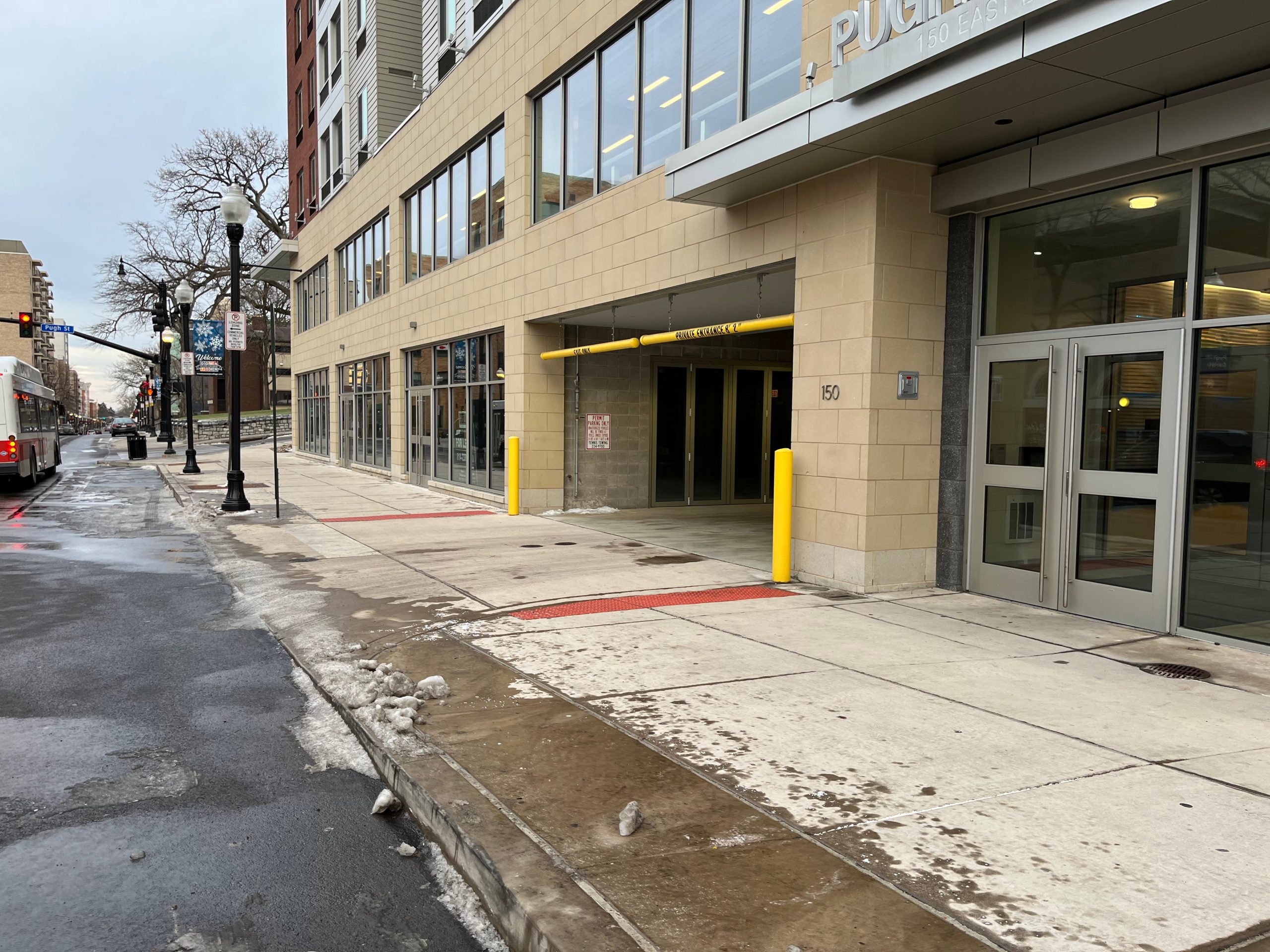
Prohibit garage entrances, like this one at the Pugh Centre, from important streets and eliminate minimum parking requirements to improve safety and increase store frontages 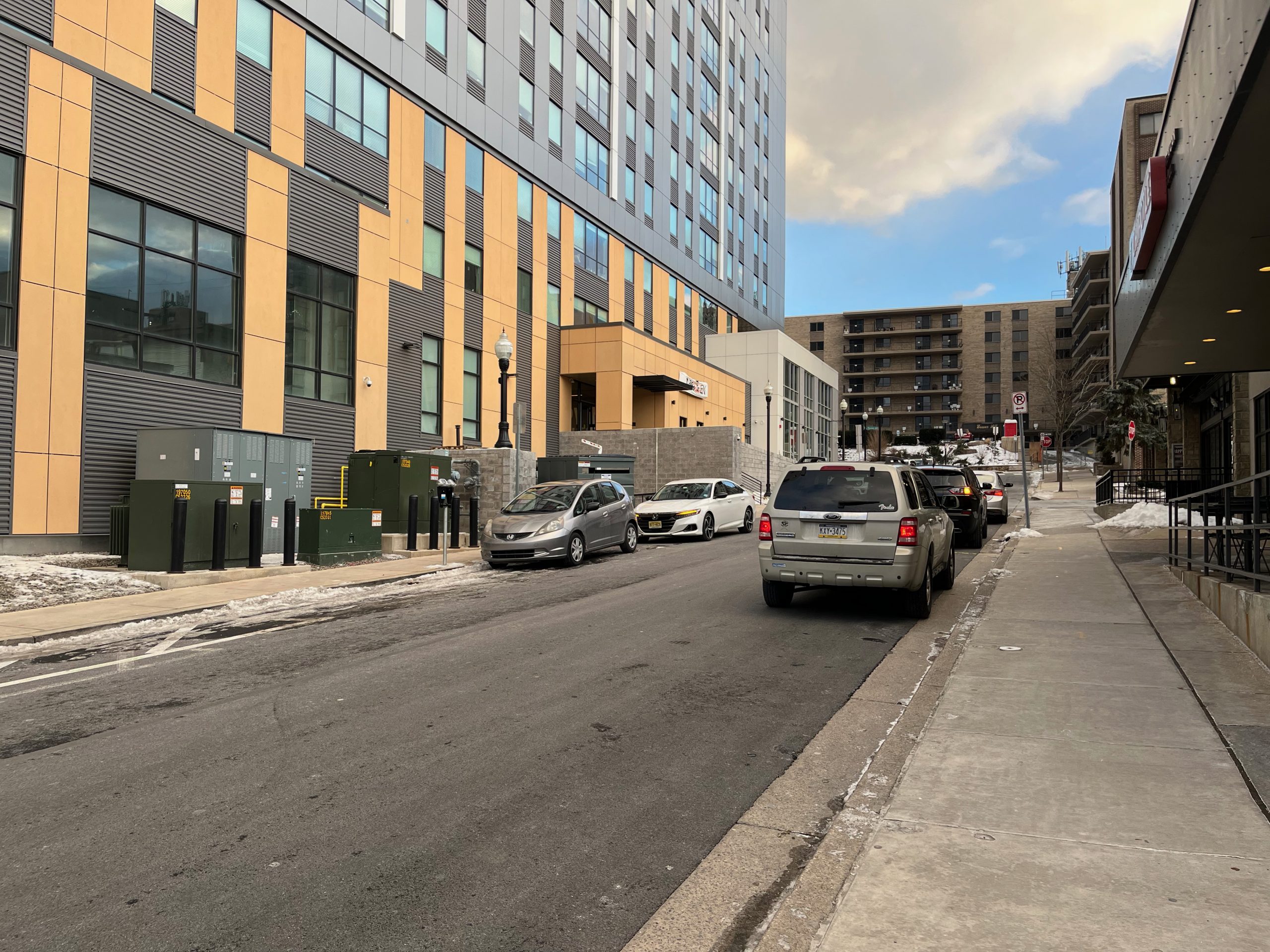
Encourage building services on the least important street frontage, like the HERE development concentrates them on Heister St
- Enforce fast, comprehensive removal of snow and ice on sidewalks, especially downtown on sidewalks which are narrow, sloping, or near fast-moving vehicles. This includes piles at crosswalks between the sidewalk and the street which are especially challenging to navigate by people with strollers and with mobility challenges. Additionally, 60 ft of sidewalk must be cleared completely—from curb to building facade—at CATA bus stops to provide space for people waiting and to ensure riders boarding and alighting buses are not faced with snow banks between the bus and the sidewalk. Alternatively, use snow removal equipment for shared-use paths and protected bike lanes to centralize sidewalk snow removal downtown, potentially with coordination and/or funding by the Downtown Improvement District.

White Loop riders are greeted by a snow bank as they alight at Penn State’s Elliott Building on Burrowes St 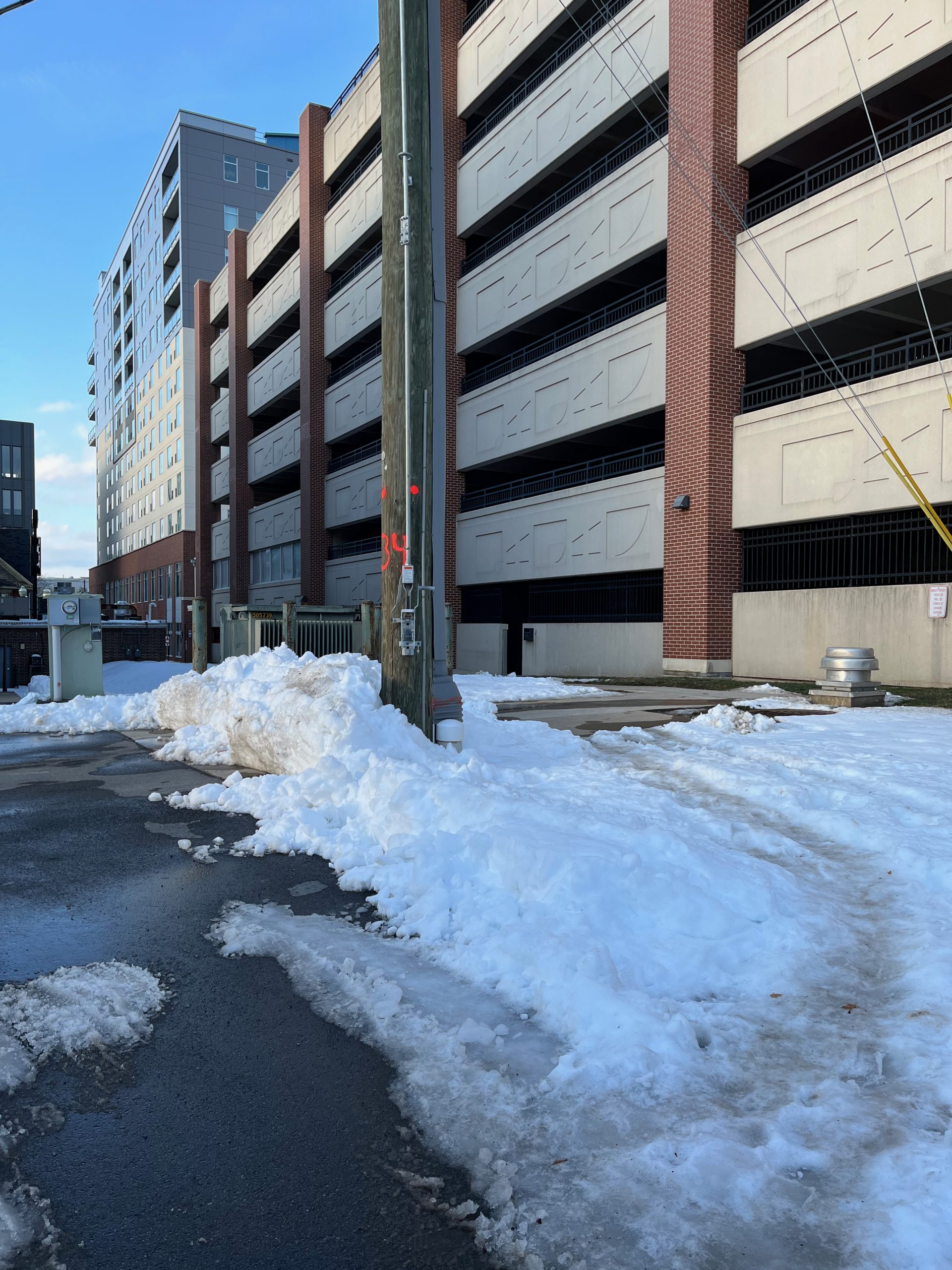
Often plows and shovelers leave piles of snow between the street and the sidewalk, like behind the Beaver Garage, forcing people to navigate the gap; especially hard for people with mobility challenges 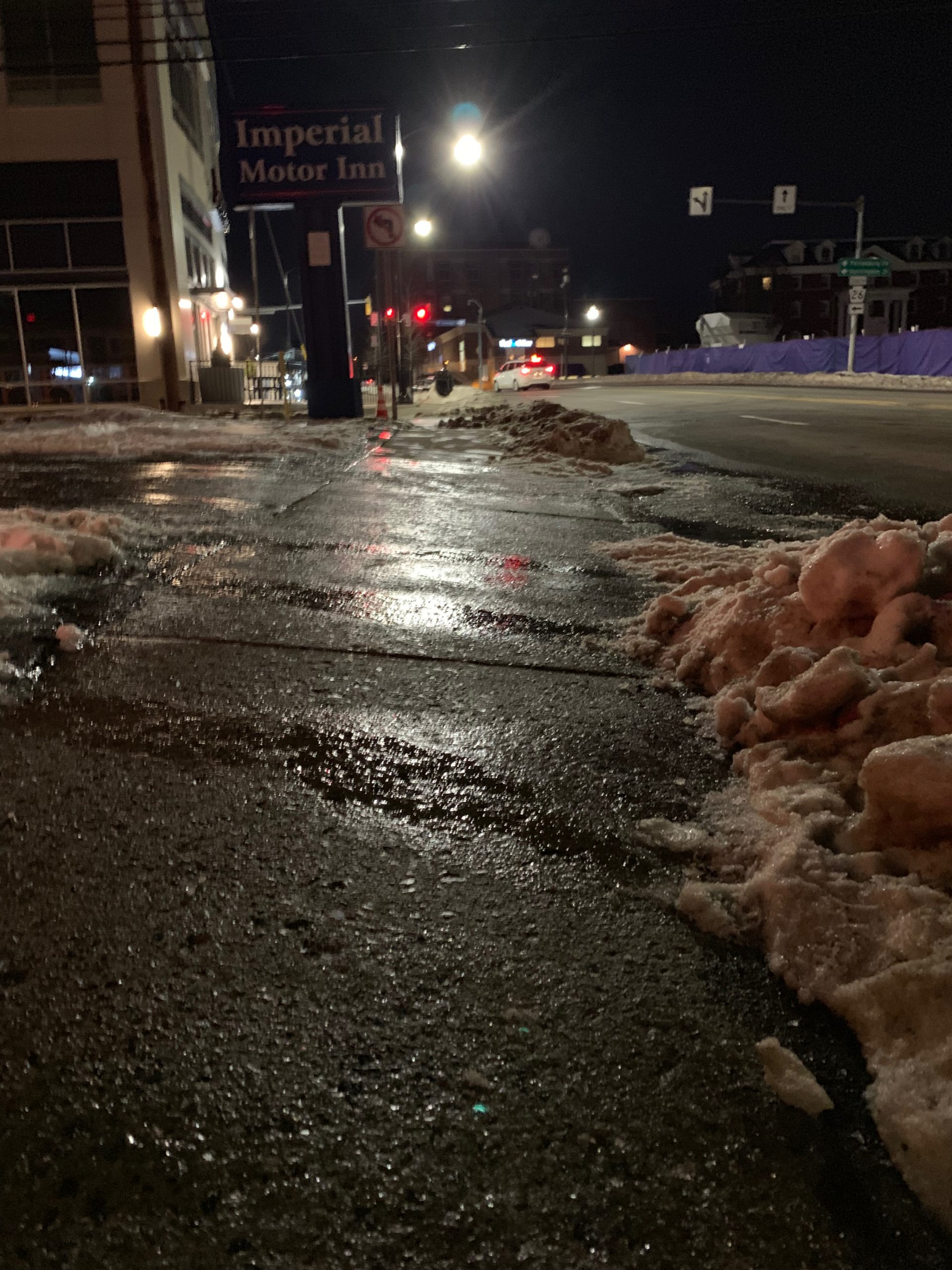
Chronic poor snow and ice removal at the site of the Imperial Motor Inn makes this stretch of narrow sidewalk, sloping toward fast-moving vehicles on Atherton St, a serious hazard 
CATA bus riders are forced to wait in the path of people moving on the sidewalk because the boarding and waiting area has not been cleared of snow at The Graduate on Atherton St
- Seek funding to transition highway-like free-flowing intersections and interchanges into slower, pedestrian friendly urban street crossings. Today, traffic whips around the corner from High St to College Ave, usually preventing people on the sidewalk from crossing. The borough should continue to pursue curb reconstruction for tighter, slower turning radii; a pedestrian and bike connection to the university; and a traffic light at this intersection. The highway-like interchange at University Dr and College Ave is no longer justified by the vehicle traffic volumes it serves. An at-grade intersection would better accommodate people on sidewalks, bikes, and transit, and even in vehicles. Potentially, the sale of land currently occupied by highway cloverleafs could pay for part of the reconstruction of this interchange, the High St at College Ave Intersection, and a road diet on College Ave. State College led the nation in pedestrian safety by implementing Leading Pedestrian Intervals and should continue toward Vision Zero.
Cars endanger people crossing High St as they speed onto College Ave; footsteps show a pedestrian and bike connection to campus is warranted
State College can better design for people biking:
The Centre Region has many high-quality suburban shared-use paths, and plans for many more. However, the region has no urban protected bike infrastructure. Protected bike lanes and protected intersections—protected from cars with buffer space, bollards or curbs, and often parallel parking—are the bicycle infrastructure solution in urban environments. Depending significantly on how the borough plans to deal with snow, protected bike lanes can be installed at sidewalk level, street level, or in between. On quieter neighborhood streets, bike boulevards which limit speeds and vehicle through-traffic volumes provide low-stress bike routes.
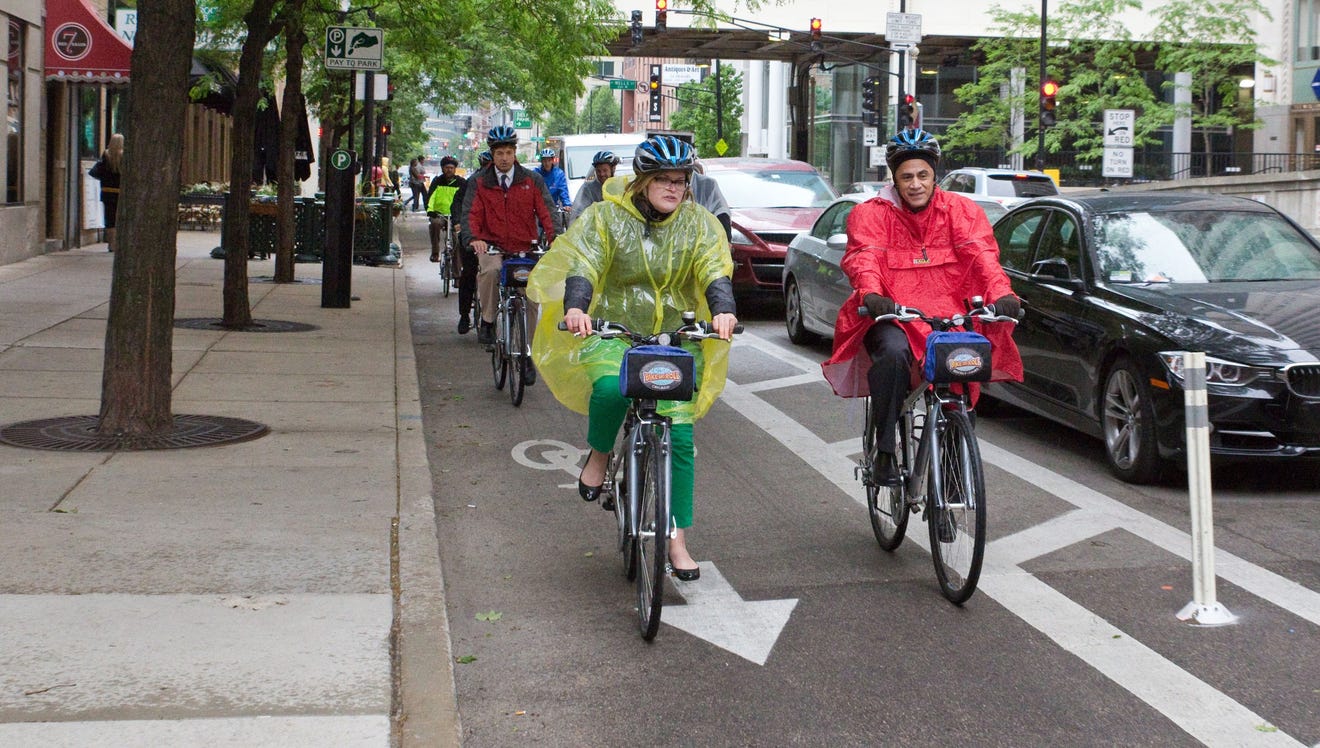
Protected bike lane with painted buffer, flex posts to keep vehicles out, and parallel parking as barrier (USA Today) 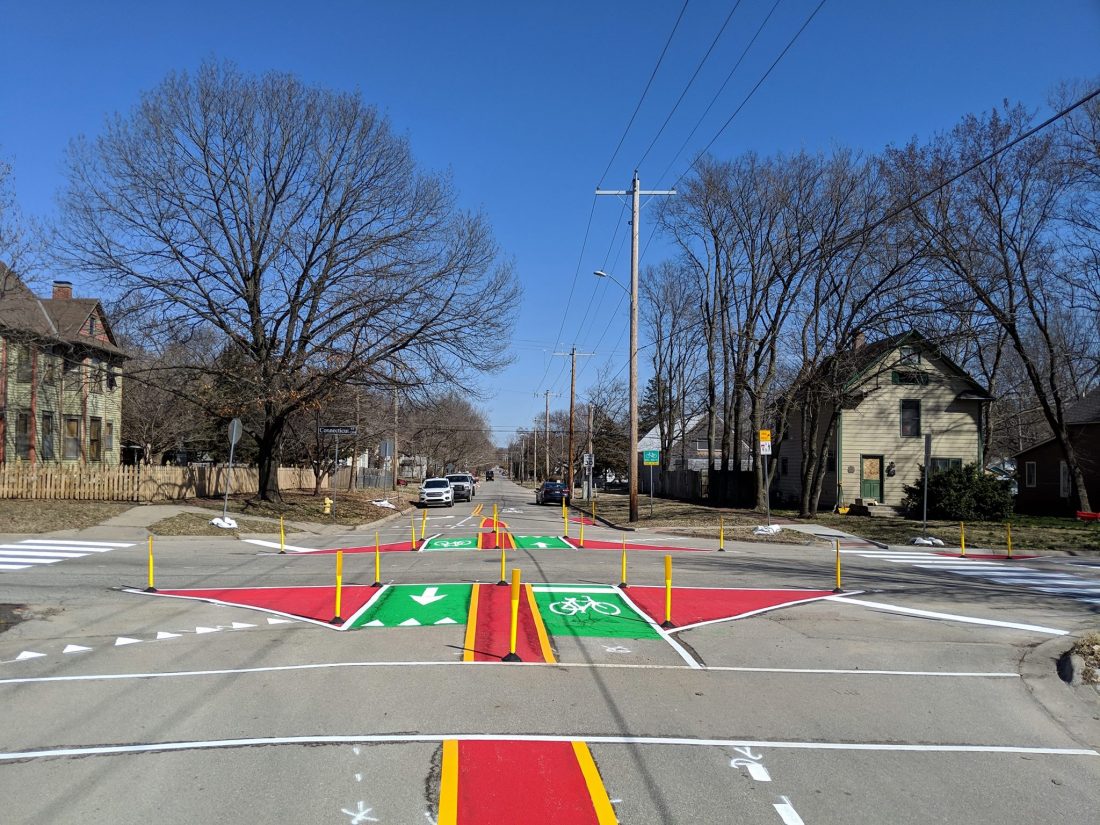
Right-in-right-out treatment to limit vehicle traffic volumes on bike boulevard (City of Lawrence) 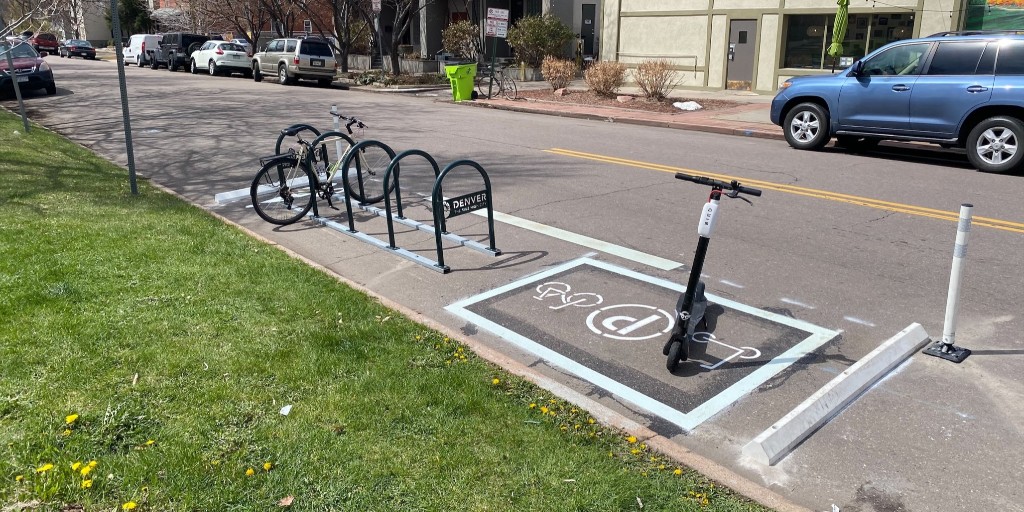
Bike parking replacing one parallel parking stall: a solution to lack of SPIN bike parking throughout the borough (Denver DOTI)
Where people ride bikes on sidewalks illegally or park SPIN bikes in incorrect locations, we should see a mandate to provide safe, protected infrastructure and convenient bike racks in those places.
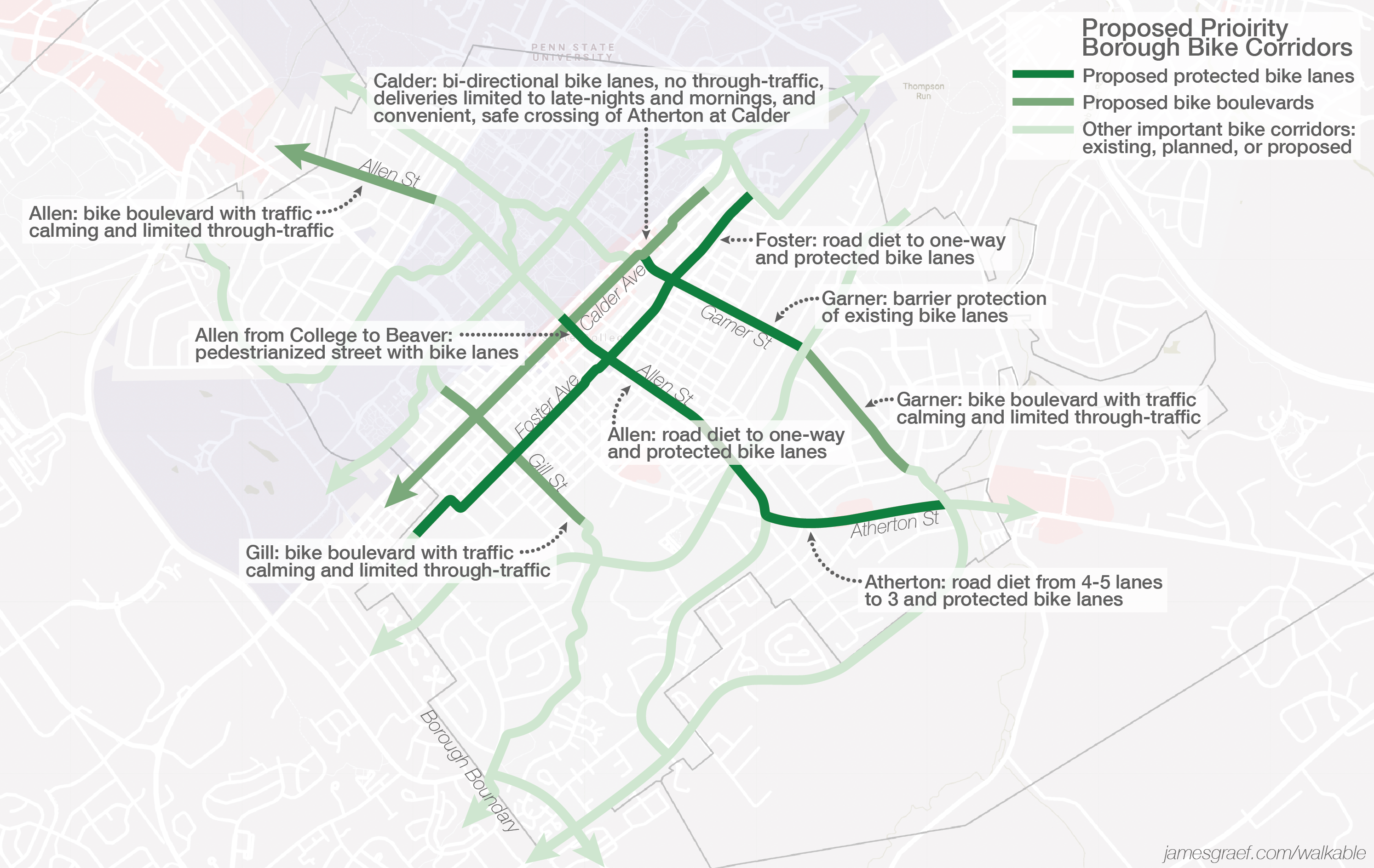
A few borough corridors deserve especial attention:
- A north-south link along Allen St and S Atherton St composed mainly of protected bike lanes on streets with traffic volumes that warrant road diets. Allen St hosts 3,481 cars per day between Beaver Ave and Atherton St in both directions combined, parallel to Atherton and Pugh Streets’ combined 18,530, so could become one-way without increasing congestion. South of its intersection with Allen St, Atherton St hosts 13,030 cars per day; a three lane road diet has capacity for 20,000 cars per day.
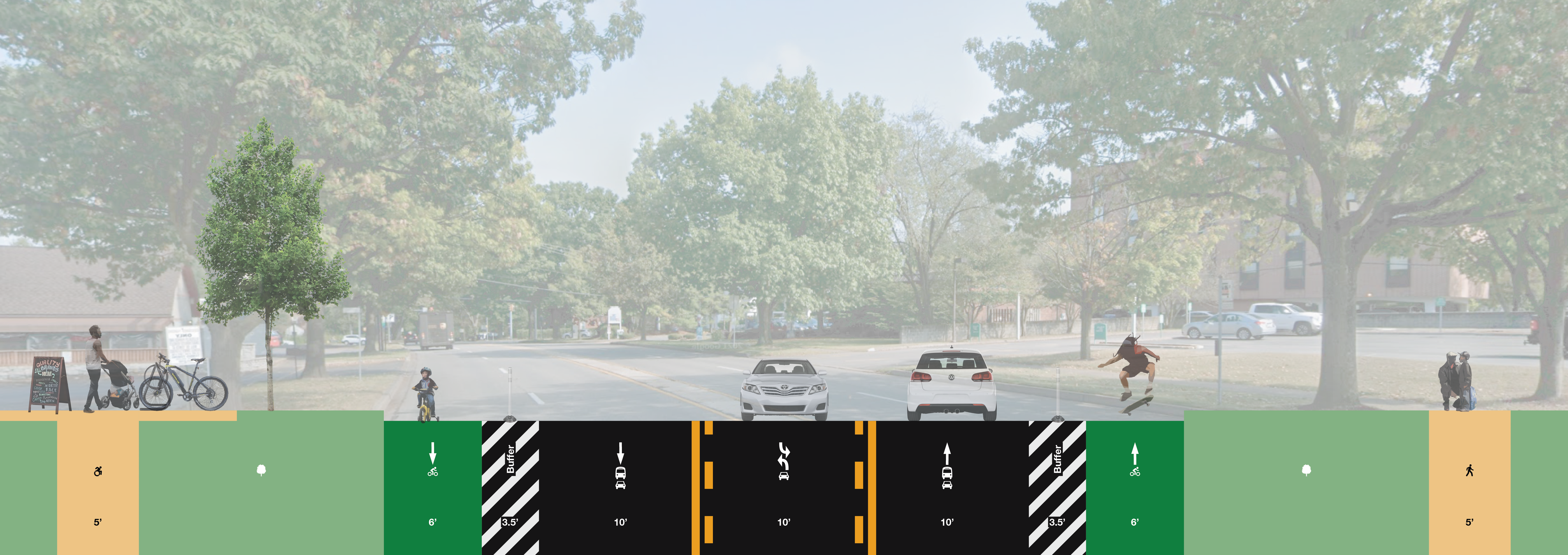
Atherton St at Allen St: road diet to 3 lanes provides space for protected bike lanes
- A route connecting destinations downtown via Calder Way with bi-directional bike lanes, right turn-only restrictions to eliminate through-traffic, and deliveries limited to lane-nights and mornings when fewer people are biking. To reach the West End, the bike route must cross Atherton St at Calder Way conveniently and safely. There is about a thirty-second gap in vehicle movement every light cycle on Atherton St between College Ave and Beaver Ave when people on bikes could safely cross with auxiliary signals.
Calder Way at Burrowes St: limiting deliveries by time of day and vehicles to local traffic provides space for a bike boulevard
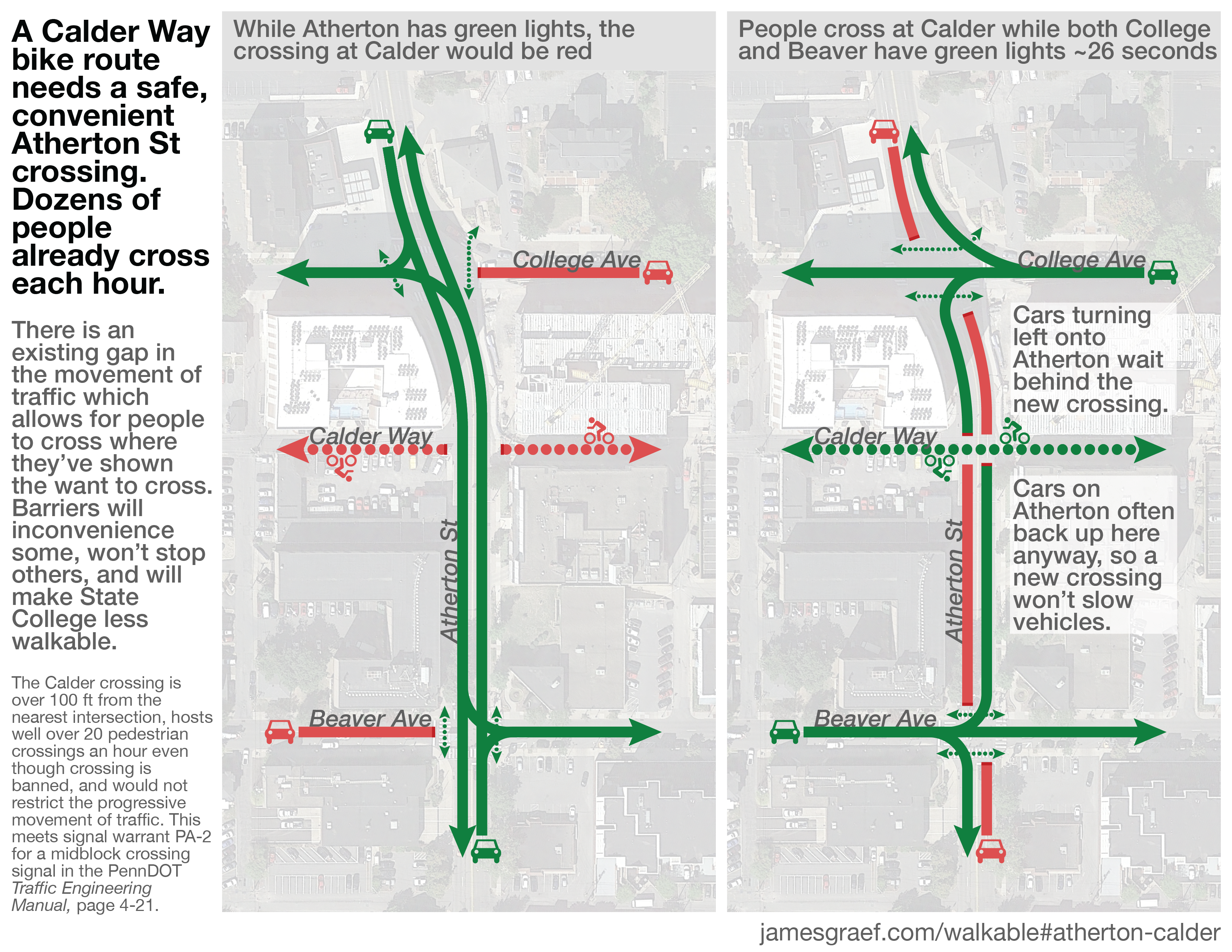
- Another east-west route on Foster Ave for less stressful travel circumscribing downtown with protected bike lanes. Already, a median island at Atherton St, right-in-right-out island at University Dr, and the Central Parklet bike path limit vehicle through-traffic. Foster Ave hosts 100 to 2,000 cars per day in both directions combined, parallel to College and Beaver Avenues’ combined 20,737, so could become one-way without increasing congestion.
- North-south links on Garner St to Atherton St and Gill St connecting to the Orchard Park shared-use path. Barriers should be added to the existing bike lanes on Garner St, and bike boulevard treatments should be used on the remaining segments.

State College can better design for people on transit:
- Rather than requiring parking in new development downtown, require contributions to White and Blue Loop CATA bus service for increased frequency, capacity, and span of service.
- Instead of building bus pull-offs, create sidewalk extensions in parallel parking lanes at bus stops to ensure buses are not slowed by needing to pull back into traffic. Where pull-offs are necessitated by schedules at the College at Allen stop, provide a queue jump at the Allen St signal to give buses priority.
Build bus stop bulb-out extensions into parallel parking lanes so buses don’t need to pull back into traffic (NACTO)
- In new developments adjacent to CATA bus stops downtown, require or incentivize indoor, heated bus waiting areas open to the public with appropriate signage, seating, and a view of approaching buses. Lobbies for residential units could be opened to the public to serve as these waiting areas. Indoor waiting areas should be supplemented with outdoor bus stop shelters for waits in warmer weather and to keep riders dry and visible to bus operators as buses approach.
- Implement transit signal priority to speed buses at key intersections. The highest priority intersections serve the White Loop, which averages almost as many riders per hour per bus (131) as the bus line with the most riders per hour per bus in New York City, (Bx12 SBS: 134) and therefore the US:
- Burrowes St turning onto Beaver Ave
- Burrowes Rd crossing College Ave
- Ramp from College Ave nearest the Meridian at University Dr
- Beaver Ave and College Ave

Transit signal priority could extend green lights on Burrowes Rd at College Ave and start green lights earlier on Burrowes St at Beaver Ave to speed White Loop travel through the area
- Allow road closures for events like races, parades, and festivals along CATA routes only after careful consideration of alternatives. Closing College Ave and Beaver Ave to bus traffic should be extremely rare because there is no alternative route through downtown and closures disrupt a large proportion of important CATA bus routes.
- Ensure bus stops are quickly and comprehensively cleared of snow and ice.
- Create a program for free holiday CATA transit fares to downtown businesses in parallel to the free holiday parking program run by the Downtown Improvement District. The holiday parking program subsidizes cars by around $100,000 in free parking each year. A merchant-validated free transit fare program through the Downtown Improvement District would likely cost much less but would subsidize disproportionately lower-income people traveling via transit: more sustainable, safer, and more equitable than car travel.
- Advocate for dedicated bus lanes on campus, especially the block of Curtin Rd from Burrowes Rd to Allen Rd eastbound. When warranted, consider future bus-only transitways downtown: for example, College Ave could be a two-way transitway and Beaver Ave could host two-way vehicle traffic.
- Advocate for the reinstatement of a CATA stop on College Ave at the University Club near Burrowes St, ensure a stop remains on Atherton St southbound between College Ave and Beaver Ave, and advocate for new north- and southbound stops on Atherton St adjacent to the West End and Penn State campus. Fears of potential marginal increases in jaywalking, fences inconveniencing pedestrians, and vehicles slowed by buses are not legitimate reasons to limit transit service access in large parts of downtown. Learn more.
Learn more about improving CATA service: CATA Operations Improvement Report.
Reimagining the University Dr and College Ave interchange as an at-grade intersection and extension of downtown could create new community space, increase housing supply, and improve transportation efficiency for people on sidewalks, on bikes, on transit, and even in cars.
Jump back to a section:
Ensure inviting ground floors; allow developers freedom on floors 2+
Demand flat, flexible sidewalks with multiple tall storefront entrances following the sidewalk’s slope and support for local businesses in exchange for taller, denser buildings with more housing and less parking.
Eliminate parking minimums to align zoning to values: sustainability, safety, and equity
Like cities across the country, stop mandating new parking to decrease housing costs, make streets safer, increase spending downtown, and make State College more sustainable.
Allocate street space to encourage sustainable, safe, equitable transportation
Build infrastructure to the places people on sidewalks, bikes, and transit want to be: new crosswalks, wider sidewalks, protected bike lanes, bike boulevards, transit signal priority, and bus stops on Atherton.
